






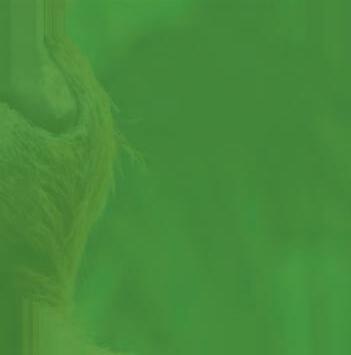
HANG WITHNI
Friday 1 December -


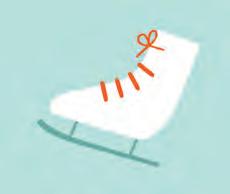









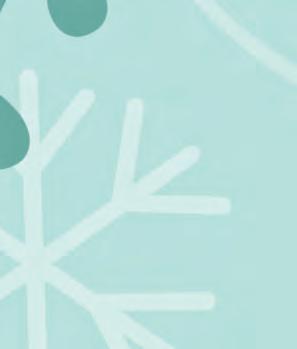









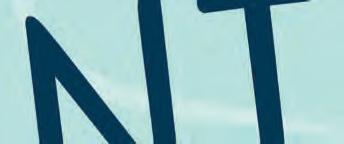















Sunday 7 January
Cosy up with a festive cocktail, enjoy delicious food and drink and wander our festive market stalls!
Book now
edinburghzoo.org.uk/winter-village

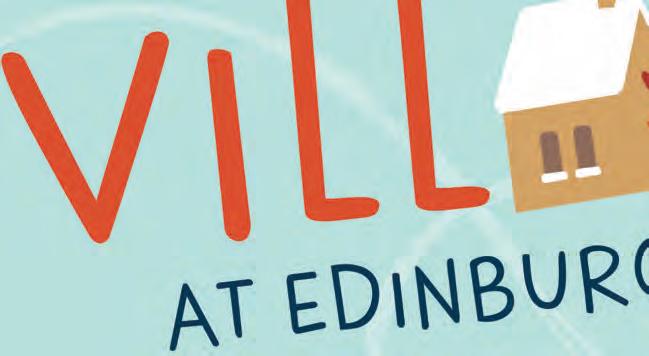
'RZSS
This is the official publication for members of the Royal Zoological Society of Scotland (RZSS), the wildlife conservation charity (Scottish registered charity SC004064)
Your membership magazine and its envelope are made using paper from sustainably managed forests and are recyclable. For more information about RZSS,including details of our patrons, board and staff, visit rzss.org.uk
All content in this magazine is © RZSSunless stated otherwise.
For any editorial enquiries, please write to Membership, RZSS, 134 Corstorphine Road, Edinburgh EH12 6TS
Or email us at membership@rzss.org.uk
Thanks to the support of playersof People's Postcode Lottery

RZSSEditorial Team
Celia Brady, Allie McGregor, Laura Moore, Christine Moorhouse, Lisa Robshaw, Ben Supple, Hollie Watson
Editor Emily Radway

Contributing Editor

Jonathan McIntosh
Art Director George Walker
Photographer Laurie Campbell
Managing Editor Andrew Littlefield

Production Director Justin Masters

Client Engagement Director
Rachel Walder
Executive Director John Innes
Commercial Partnerships Director


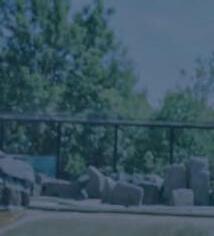
Sonal Mistry d: 020 3771 7247
e: sonaLmistry@thinkpublishing.co.uk
Published by T H I N K
w: www.thinkpublishing.co.uk
The beautiful animals you love to visit at Edinburgh Zoo and Highland Wildlife Park play a vital role as ambassadors for their cousins in the wild. Right now, encouraging everyone to protect, value and love nature could hardly be more important.
With more than a million species at risk of extinction, our planet's life-support system is in crisis. Globally, extinction rates are at least 100 times higher than 'normal' background rates. Sadly, 49% of species in Scotland have declined in number, and one in nine is threatened with extinction.
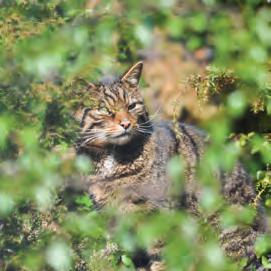
At the Royal Zoological Society of Scotland (RZSSJ,we have pledged to reverse the decline of at least 50 species over the next decade. You can read about that pledge and how we're working towards our target on page 6. So far this year, we have reached important milestones with the release of invertebrates such as pine hoverflies and dark bordered beauty moths in the Cairngorms, and the first release of wildcats into the Scottish Highlands (read more on page 26).
Although we're making great progress with partners to safeguard and restore wildlife in Scotland and globally, the reality is that the world's biodiversity is vanishing fast. That's why we recently called on the Scottish Government to consider a national programme of species recovery alongside a national programme of ecosystem restoration. Species depend on habitats, and together they form our planet's essential ecosystems -both habitats and species must function in harmony to create sustainable, abundant and diverse life on Earth. Here at RZSS,we will continue working hard to inspire and empower individuals and communities to make a difference. Through our zoos and our global reach, we can help people realise the benefits of being close to nature and inspire others to protect, value and love it as much as we do.
Contributing Editor Jonathan McIntosh visited Edinburgh Zoo to meet our meerkats and find out what makes them so engaging.

-' -' UJ
THE WILDLIFE CONSERVATION CHARITY
i CONTRIBUTORS u UJ °' w 0:: w i's u
Conservation journalist Richard Rowe has been catching up on the latest news from a big year in the Saving Wildcats project.
r1J
David Field, Chief Executive Officer
RZSS.ORG.UK I WINTER 2023 3
Editor Emily Rodway spoke to some of the keeper team at Highland Wildlife Park to hear all about this summer's baby boom!
Your membership
As well as helping the animalsyou love, as a member you enjoy these benefitsand more...
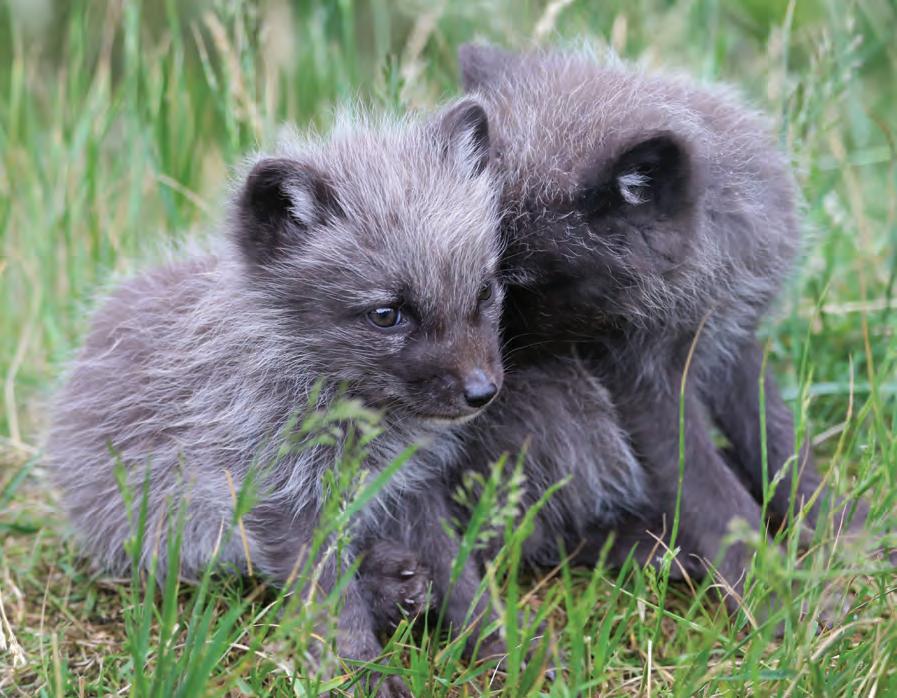
Unlimited days out at Edinburgh Zoo and Highland Wildlife Park, with discounts for family and friends that come with you.


A handy 10% discount in our gift shops -ideal in the run-up to Christmas! You're entitled to 10% off in our cafes and restaurants too.

Free parking at Edinburgh Zoo. Remember to get your ticket validated at the members gate or admissions before you leave.

Reduced price admission to our fantastic events. Turn to page 43 for details of this year's very special Winter Village at Edinburgh Zoo.
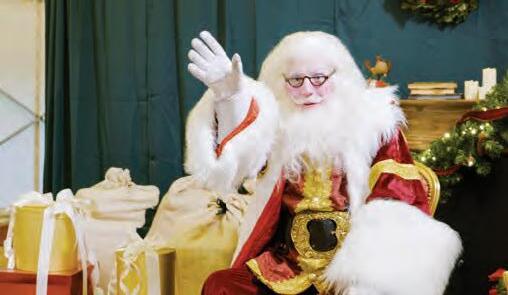 Nico the sloth Nico, who moved into Edinburgh Zoo's Sloths and Armadillos building this summer, was recently photographed by nature photographer Laurie Campbell
Nico the sloth Nico, who moved into Edinburgh Zoo's Sloths and Armadillos building this summer, was recently photographed by nature photographer Laurie Campbell
'RZSS THE WILDLIFE CONSERVATION CHARITY
4 WINTER 2023 I RZSS.ORG.UK
It's
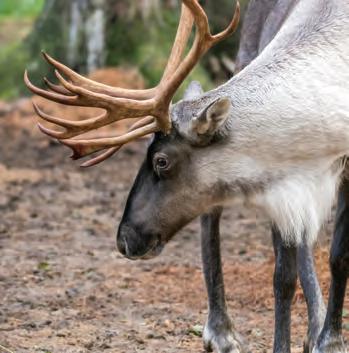

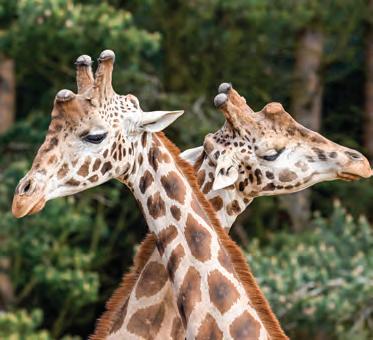



6 Protected, valued and loved How we're reversing the decline of 50 species 8 The big picture Giant lime green stick insect 11 Latest news from our parks 14 Conservation updates 16 Animal collectives Discover quirky group names for our animals
A day in the life of Nico
Zoo's charismatic male sloth
Baby boom!
18
Edinburgh
20
at Highland
Park 26
the wild
Meet the youngsters born
Wildlife
Into
been a huge year for the Saving
32 European
reindeer
Wildlife Park 34 Meerkats are go!
Sellar,
of hoofstock and
looks back over 30 years with RZSS
guide
to support our charity
you for all your help
Wildcats project
forest
Learn about these charming residents of Highland
As we make plans to bring meerkats to Edinburgh's children's hospital, our journalist pays a visit to the two clans living at the zoo 40 Highland Wildlife Park through the years Morag
team leader
wolves,
43 Member
Including Edinburgh Zoo's Winter Village 47 Ways
Thank
48 In our shops
Great ideas for Christmas gifts
CONTENTS RZSS.ORG.UK I WINTER 2023 5 ::J UJ cc "-::;: i) UJ °' (/) ti: u 0 ...J ,j:
50 A moment I'll never forget Giraffe experts swap jobs with whisky makers!
At RZSSwe have a bold vision: a world where nature is protected, valued and loved. One of our key three pledges to achieve this vision is that we will reverse the decline of at least 50 species by 2030.
There are many threats that have led to the decline of species, including habitat loss, hunting, climate change, pollution and disease. Globally, one million species are threatened with extinction. In Scotland, 49% of species have declined in number and a staggering one in nine are threatened with extinction.
As a wildlife conservation charity, we help threatened animal species living in a wide range of habitats in Scotland and around the world. When determining where to invest our skills and resources, we always work in a way that promotes species conservation as a positive driver V> for wider ecosystem recovery, and we make sure that such work is aligned

with recovery efforts for other threatened species sharing the same habitat.
We also select projects where our unique set of skills is put to best use -skills including conservation breeding (ex-situ conservation), conservation translocations (for example, reintroductions), applied conservation genetics, veterinary medicine and conservation planning.
Teaming together
We know that recovering a species is not something that can be done overnight. Successful species recovery efforts require many people and organisations to pool their expertise and resources for the common good. So, our approach is to work in partnership, as it's rarely possible for an individual or even a single organisation to save a species.
We make a long-term commitment to the process of recovery, because species
cannot recover without healthy habitat to support them. And we use science and conservation planning to support our decision-making.
Species recovery projects go through different steps, including monitoring populations to diagnose what the issue is, agreeing and trialling a conservation intervention (such as a translocation), and then rolling it out across larger areas if the approach is successful.
From the outset of every project, we will aim to establish recovery targets and then review our progress regularly with the help of external experts.
On our local patch
Among the latest examples of collaborative working using the unique skills of the RZSSteam is the conservation breeding of the dark bordered beauty moth. As with our ongoing pine hoverfly conservation
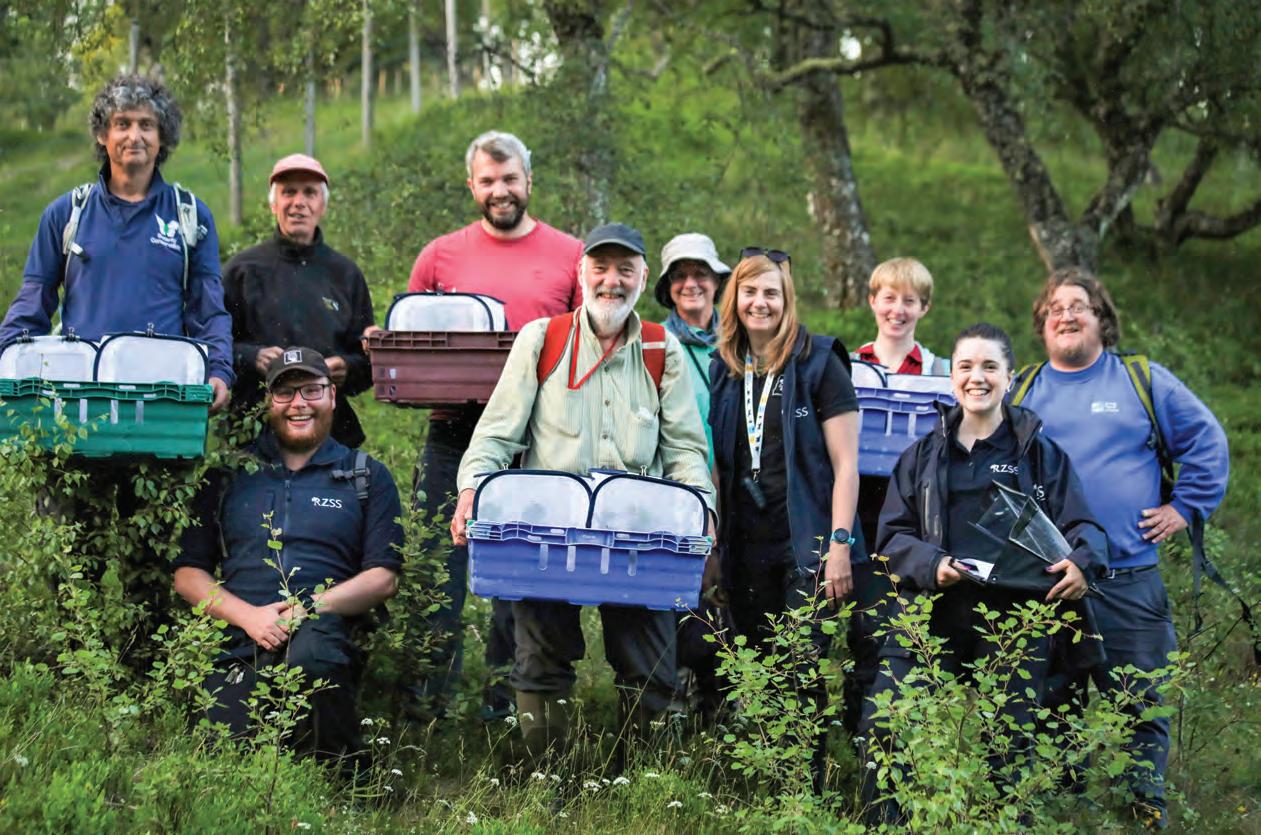 Partners in the Rare Invertebrates in the Cairngorms Project, including members of the RZSS conservation team, prepare to release dark bordered beauty moths into the wild
Partners in the Rare Invertebrates in the Cairngorms Project, including members of the RZSS conservation team, prepare to release dark bordered beauty moths into the wild
breeding programme, we work as part of the Rare Invertebrates in the Cairngorms Project (RIC} -a partnership between ourselves and Butterfly Conservation Scotland, RSPBScotland, Cairngorms National Park Authority, Buglife Scotland and NatureScot.
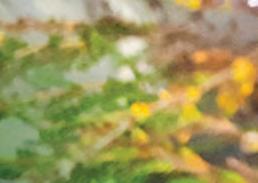


In 2022, 40 dark bordered beauty moth eggs were collected in the wild and transferred to a purpose-built breeding facility at Highland Wildlife Park. There were different types of housing for each life stage of the moth, and full climate control to give them the best chance possible of breeding. These eggs hatched out into caterpillars, pupated into adults and produced a further 497 eggs, making for a successful first breeding season.
This summer, RIC partners released 160 dark bordered beauty caterpillars into a specially selected site in the Cairngorms National Park. Other individuals remain at the Highland Wildlife Park as part of the conservation breeding programme, through which we are gaining new insights into the reproductive and ecological behaviours of this beautiful species.

Using conservation genetics
A significant part of our conservation and science work is conducted via RZSSWildGenes, a lab-based team at Edinburgh Zoo that carries out cutting-edge conservation genetic and genomic research on a large range of threatened species.
One of the most fascinating recent projects for the RZSSWildGenes team has been focused on the addax, a critically endangered antelope that once roamed across the Sahara Desert. Our scientists have undertaken the first global assessment of the animal's genetic diversity. This provides a unique insight into the last remaining wild population (which has fewer than 100 individuals left due to threats from climate change, hunting and habitat loss} as well as captive populations and those already reintroduced to Tunisia.
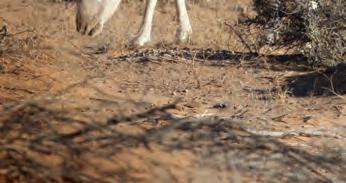
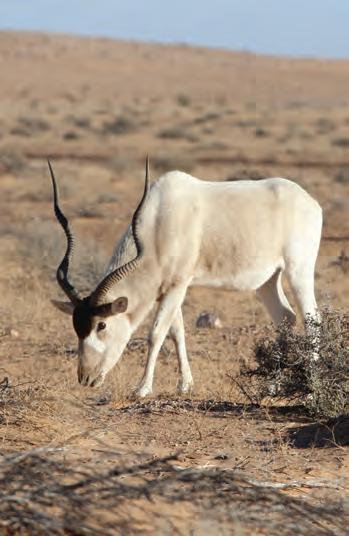
We have found that the genetic diversity in the last wild population is greater and different to that in captivity,
highlighting the importance of both these populations for conserving addax. The genetic information identified through our work has also been used to select individuals to act as founders of a reintroduction project in Chad. Further projects benefiting from the skills of the RZSSWildGenes lab include those to protect endangered crocodiles and elephants in Cambodia, and to monitor the Giraffe Conservation Foundation reintroduction programmes across Uganda.
Whywedoit
The Species Survival Commission of the International Union for Conservation of Nature (IUCN} outlines numerous reasons why it's critical that those of us who have the skills and resources to make a difference should work to save species that are at risk of extinction.
Species and their interactions with each other are the fundamental building blocks of the ecosystems in which they live, whether that's in forests, mountains, seas or savannahs.
Certain 'keystone' species, such as pollinators and predators, are essential to regulating interactions between the other species that make up an ecosystem. And many species also have a strong cultural value to the human communities that live alongside them.
With more than a million species currently at risk of extinction, nature needs us all more than ever. As a member of RZSS,you are helping support our skilled scientists, geneticists and conservationists in their work to reverse the decline of at least 50 species by 2030. We'll keep you updated on our progress through future issues of this magazine. Thank you for your
To get involved and help support our work, please visit rzss.org.uk/savingspecies
RZSS.ORG.UK I WINTER 2023 7

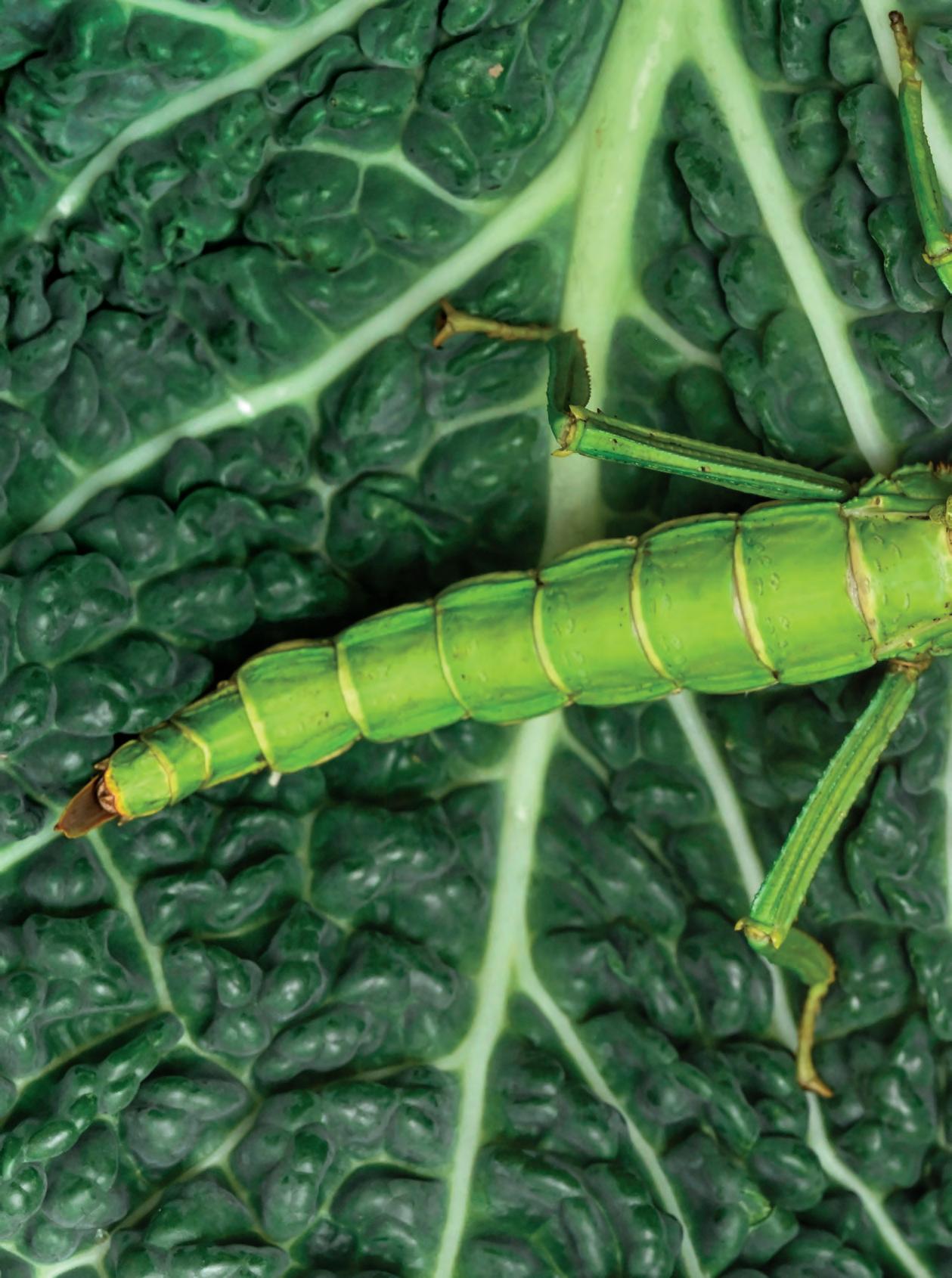

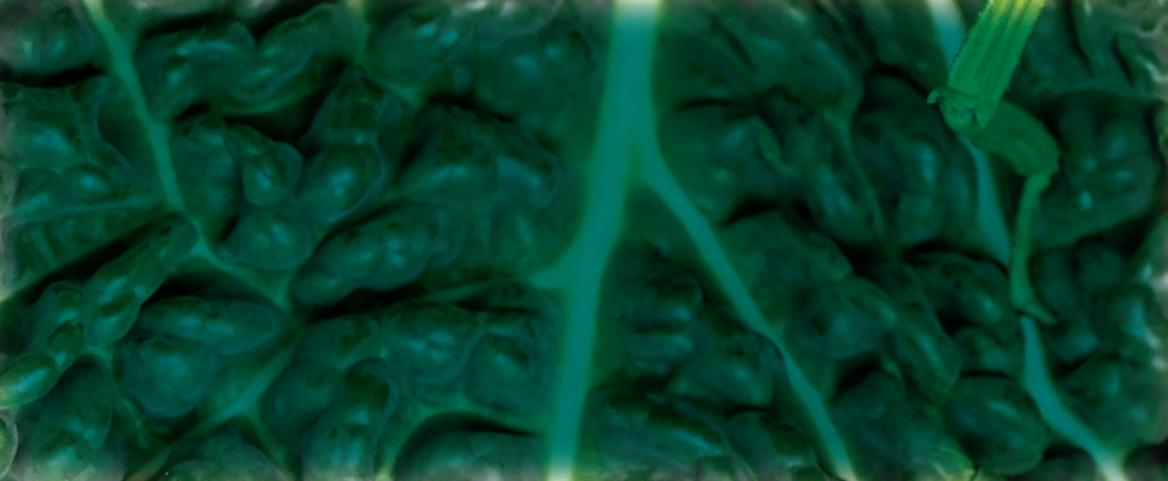

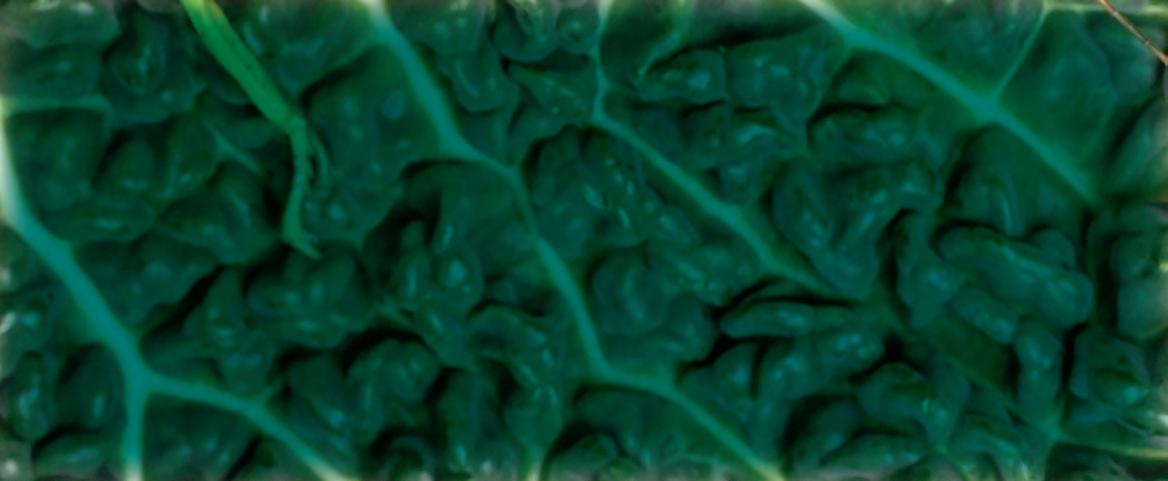
WI D~t«l DIS OVER!
EXPERIENCE MORE Av,ard-Winning Wildlife Watching Holidays
Scotland & beyond
Small Groups - Two Leaders - Fully Inclusive Amazing Wildlife Experiences Supporting Conservation
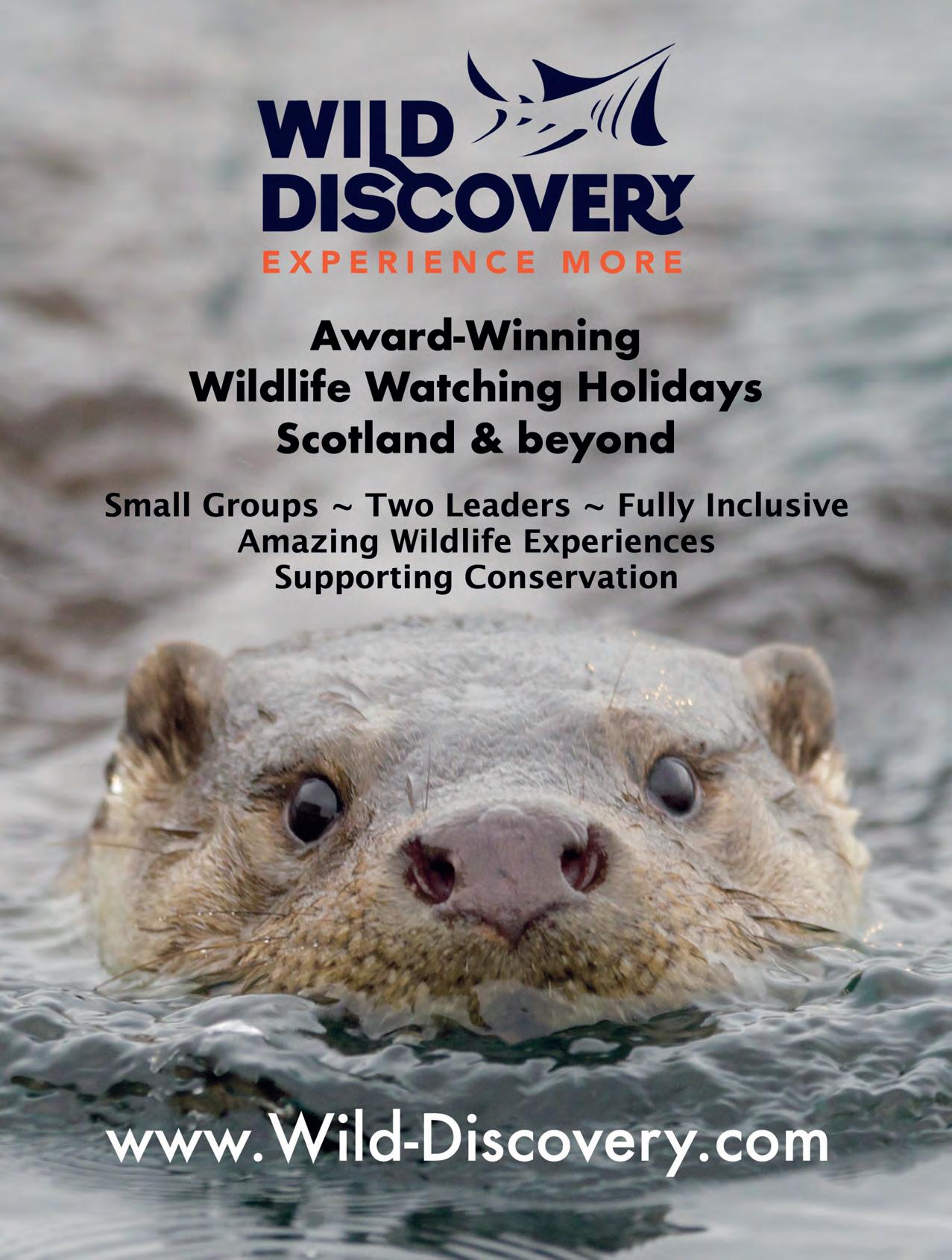
SOW VERY CUTE!
Edinburgh Zoo welcomed four endangered Visayan warty piglets this summer
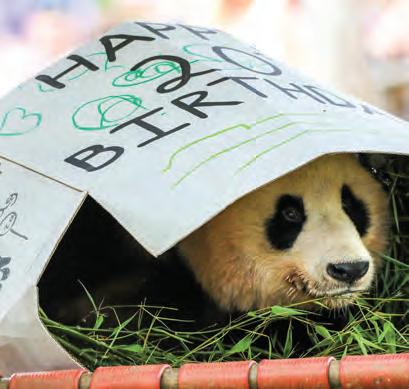
Earlier this year Edinburgh Zoo celebrated the birth of an all-girl litter of critically endangered Visayan warty piglets. Hilda, Esme, Etty and Ruth joined Nikki, Mabel, Mina, Teresa, Jacques
warty pigs remain in the wild, making the arrival of Nikki and Elvis's piglets extremely significant.
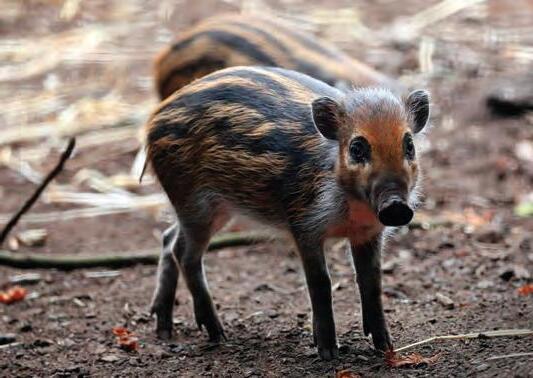
"Our Visayan warty pigs are full of character, and these and Elvis on 25 June -boosting the zoo's population to 10.
Agricultural expansion and logging have devastated their natural habitat, with hunting decimating population levels. Today, just 200 Visayan wild
four new arrivals are no exception,· says Edinburgh Zoo's hoofstock team leader, Jonny Appleyard. "They'll be incredible ambassadors for their species and will inspire more people to protect nature."
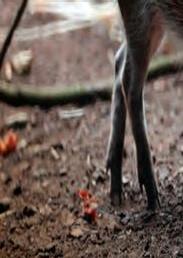
A RISE IN THE RANKS
King penguin gets a promotion
Penguins Rock resident Sir Nils Olav was promoted to major general by the Norwegian army this August for setting a superb example to the rest of Edinburgh Zoo's penguins.
The knighted king penguin was bestowed this unique honour at a special ceremony at the zoo. In attendance were more than 160 uniformed guards from His Majesty the King's Guard Band and Drill Team of Norway, who also took part in The Royal Edinburgh Military Tattoo.
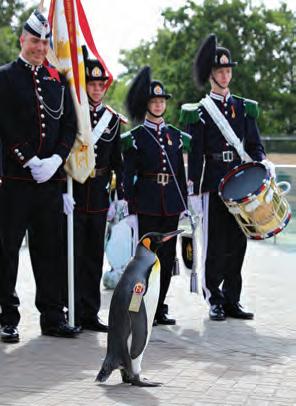
The world-famous Sir Nils -who already held the rank of brigadier -now boasts the flashy title of Major General Sir Nils Olav, Baron of the Bouvet Islands, and official mascot of His Majesty the King's Guard of Norway.
BRILLIANT BU DONGO TEAM
Fission-fusion strategy for Edinburgh Zoo's chimps scoops award
Congratulations to our incredible Budongo keeper team who bagged a trophy at the British and Irish Association of Zoos and Aquariums (BIAZA)Awards. The award recognised their outstanding efforts in implementing a fission-fusion management strategy to improve the behaviour and integration of
Zoo's chimpanzee troop.
Wild chimpanzees live in fission-
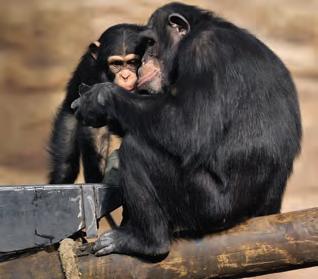
Llfusion societies, which sees them split (fission) into smaller groups for various
before coming together
(fusion) again. Budongo's fission-fusion strategy was introduced in September 2021 to improve the family dynamic between our youngest male Velu, his sister Masindi, and their mum, Heleen. Following the strategy's success, the 15-strong chimpanzee troop were reunited as one in December 2022, with fission-fusion still used occasionally to help manage them.
:::JEdinburgh
:,:
::, ::iactivities
:c:::
L 7 ~// / 0 l RZSS.ORG.UK I WINTER 2023 11
"" YangGuang V- getsthe partystarted
Dating from 1446, Rosslyn Chapel took over 40 years to complete. The beauty of its setting and the mysterious symbolism of its ornate stonework have inspired, intrigued and attracted visitors ever since.
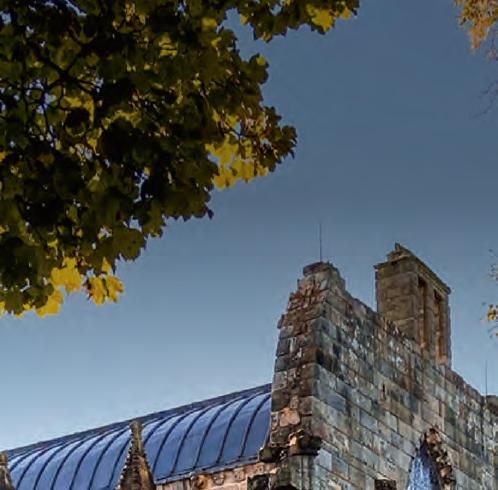
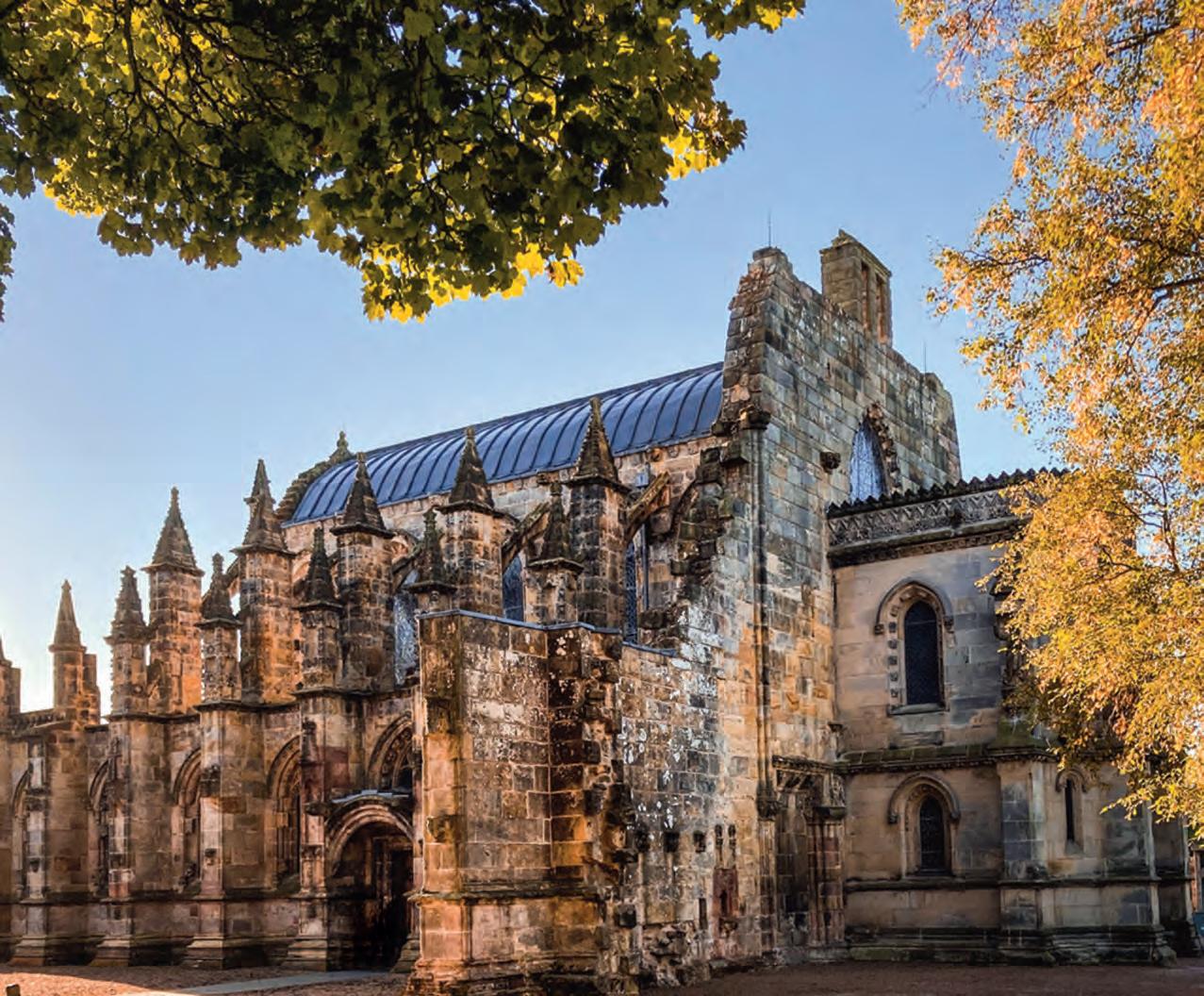
Open daily
Please book your visit in advance on our website rosslynchapel.com

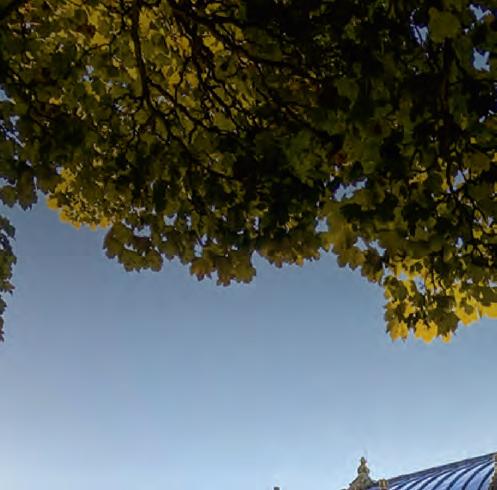
New learning programme is a great hit with Highland students
Highland Wildlife Park has teamed up with the University of Highlands and Islands (UHi) to deliver a new four-week programme designed to help participants improve their teamworking, communication and time management skills while building closer connections with nature.
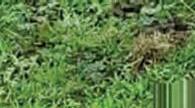
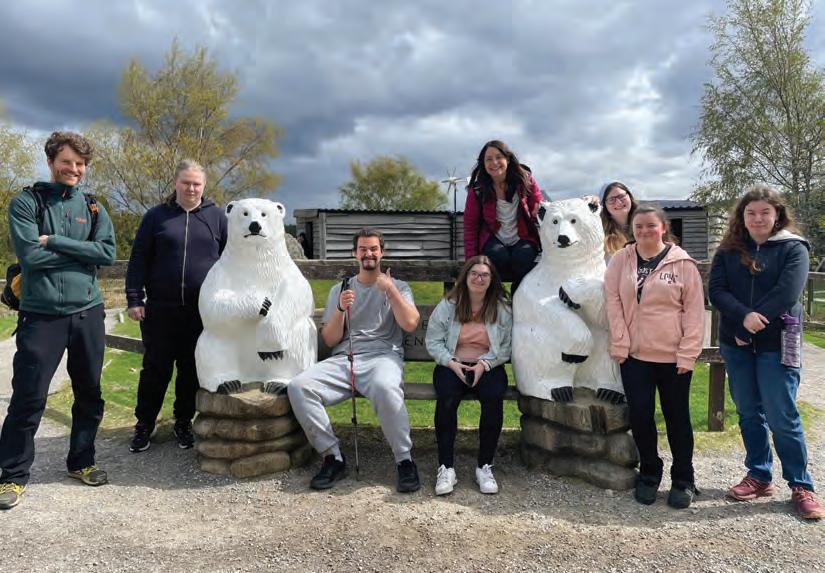
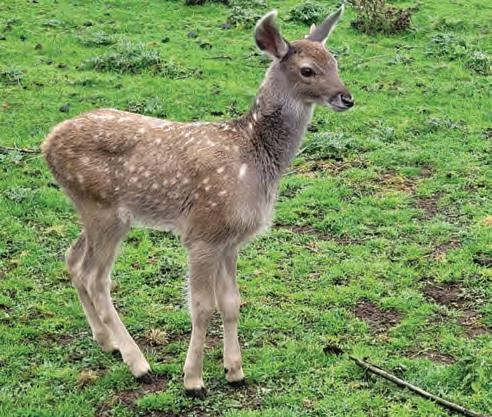
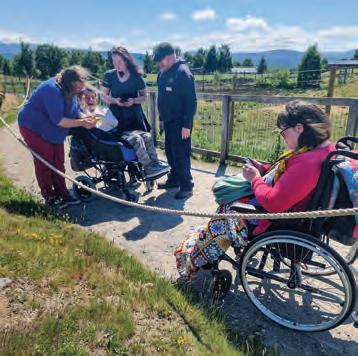
Throughout this programme, students from the university's Perth-based applied learning courses, Skill Up and Moving On, enjoyed Highland Wildlife Park's unique offerings. They shared experiences with our amazing animals and searched for native species while pond dipping and bird watching in the wildlife garden.
Feedback on the new programme has been overwhelmingly positive, with the young people involved particularly enjoying getting up close to different species and
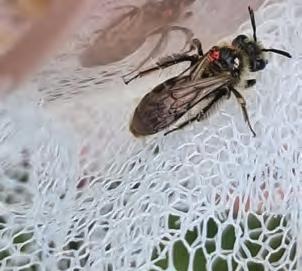
working with Highland Wildlife Park's Discovery and Learning team.
'This project was extremely beneficial to the young people who participated," says UHi Perth's Caroline Cowe.

"Their confidence in interacting with other people improved dramatically and they all expressed a feeling of wellbeing."
Student feedback has also helped to shape the direction and delivery of this programme, which is now set to be delivered to pupils at Kingussie High School.
With the opening of Scotland's Wildlife Discovery Centre at Highland Wildlife Park next year, we're hoping to deliver more community work similar to this programme -helping us to meet our pledge of enabling over 100 communities to better protect nature by 2030.
RZSS.ORG.UKI WINTER2023 13
CAPERCAILLIE CAIRNGORMS
For the last three years, the RZSS WildGenes laboratory has been working with the Cairngorms Capercaillie Project on studying capercaillie DNA to help reveal the genetic diversity of Scotland's population.
The good news is that, although the genetic diversity of the Scottish capercaillie population is low, it doesn't appear to have declined significantly during the 20th century since the first reintroductions. There was further good news from this year's annual surveys during the spring capercaillie lek, when the male birds put on elaborate displays to compete for mates.

We found an increase of 19 male birds in the Cairngorms National Park compared to last year. This was the first increase in eight years, although it is believed that overall, fewer than 600 capercaillie remain in the wild in Scotland. Lek counts and genetics data will help inform new coordinated action to save the species.
PARTNERSHIP VISIT FROM BRAZIL TO SCOTLAND



For conservation efforts to be effective, it's vital to share best practice between institutions that are trying to save a variety of species. At RZSS,we've been working with Wild Animal Conservation Institute (ICAS)in Brazil for more than 12 years. This summer, we welcomed Lucas Barreto, (below) coordinator of the Atlantic Forest unit of the ICAS Giant Armadillo Project, to Edinburgh Zoo and Highland Wildlife Park. While he was with us, Lucas enjoyed a zoo tour with the Edinburgh Zoo discovery rangers, lab visits with the RZSS WildGenes team, meetings with our skilled vets, and field trips to invertebrate release sites in the Cairngorms. We loved having the opportunity to meet Lucas and exchange knowledge between our teams.

14 WINTER 2023 I RZSS.ORG.UK
PALLAS'S CAT AWARD FOR RZSS
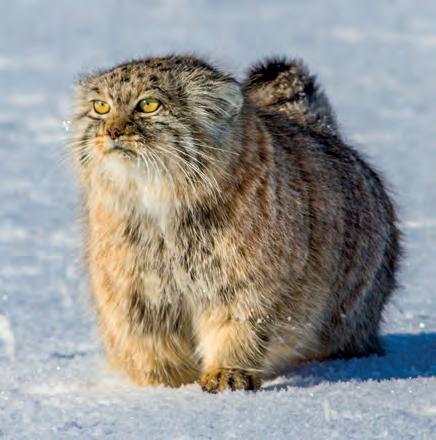




We were proud to receive a silver award in this year's British and Irish Association of Zoos and Aquariums (BIAZA) Awards for our work on the first global Pallas's cat conservation project. The Pallas's Cat International Conservation Alliance (PICA) is a partnership between RZSS,Nordens Ark and the Snow Leopard Trust. Its main aim is to increase conservation efforts for the Pallas's cat across the countries in its range, while increasing global awareness of the species and providing education and support. RZSSis also the holder of the Pallas's cat European Endangered Species Programme (EEP)and the International Studbook (ISB).
DARK BORDERED BEAUTY MOTH CAIRNGORMS

RZSShave participated in the first ever releases to boost Britain's wild population of threatened dark bordered beauty moths as part of the Rare Invertebrates in the Cairngorms (RIC) partnership. Following this extremely rare native species' successful first breeding season in a purposebuilt breeding facility at Highland Wildlife Park, RIC partners released 160 dark bordered beauty caterpillars into a specially selected site in the Cairngorms National Park. Establishing new populations of this species is vital, as habitat loss means there are currently only three small populations across Britain -two in Scotland and one in England.
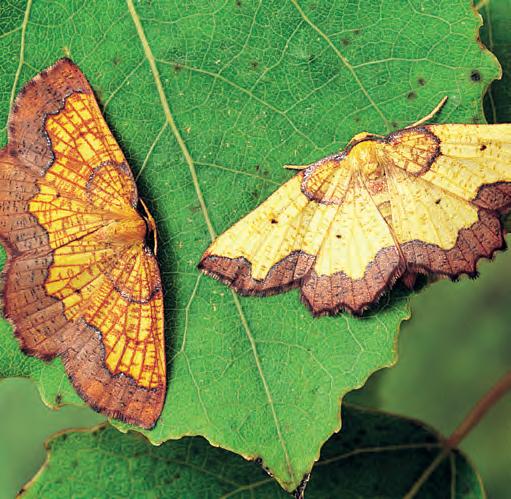
RZSS.ORG.UK I WINTER 2023 15
Also known as: raft, lodge, romp
Edinburgh Zoo's adult duo of Asian small-clawed otters, : and have so far had three litters together, in 2021, 2022 and 2023. In the wild, older offspring often stay with their parents to help raise future litters of pups.

A FLAMBOYANCE OF FLAMINGOS

Also known as: colony, stand
Edinburgh Zoo's oldest Chilean flamingos were born in 1961, with the flock's youngest members hatching in 2016. Their iconic pink colouring stems from the tiny crustaceans and algae they feast on, which they filter from water using their unusually-shaped beaks.
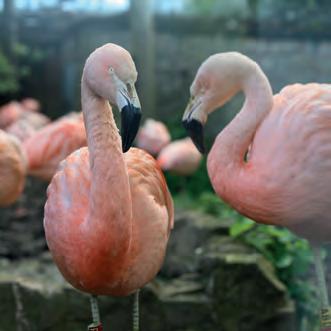
A KALEIDOSCOPE OF GIRAFFES

Also known as: tower, herd, journey

There are five Nubian giraffes at Edinburgh Zoo: • , and .....,. world's tallest mammal, giraffes· feet can measure up to 30cm in diameter and their bluish coloured tongues can grow to 50cm in length!

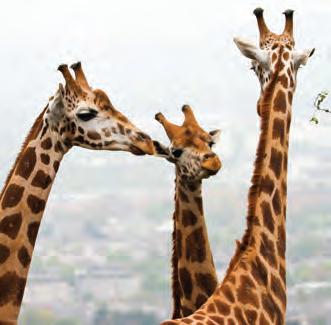
A WADDLE OF PENGUINS
Also known as: colony, rookery, huddle, raft
• , the world's only knighted penguin, is a member of Edinburgh Zoo's bachelor group of king penguins. In 1919 the zoo welcomed its first king penguin chick, making us the world's first zoo to successfully breed the species.


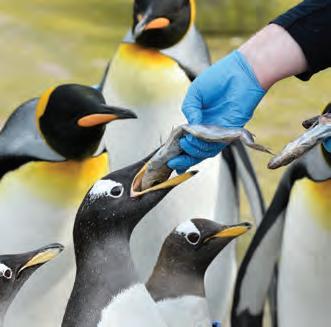
A BARREL OF CAPUCHINS
Also known as: troop, cartload, tribe, band






Edinburgh Zoo's Living Links enclosure houses two groups of brown capuchins, also known as South American monkeys. Naturally intelligent and inquisitive, capuchins have distinctive personalities and enjoy investigating objects in their environmentusually by taking them apart!
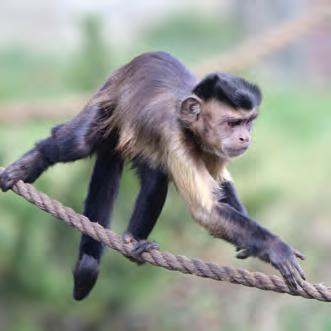
F LEMUR
Also known as: troop

Edinburgh Zoo has five red-bellied lemurs: • • and ~~~··. Found in eastern Madagascan forests, a troop of red-bellied lemurs consists of an adult breeding pair and their young of varying ages. Edinburgh Zoo is also home to troops of crowned lemurs and ring-tailed lemurs.
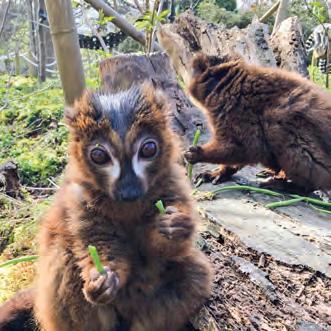
16 WINTER 2023 I RZSS.ORG.UK
THEREARESOMEAMAZING NAMESFORANIMALSWHEN THEY COME TOGETHERIN GROUPS. TRYTO REMEMBERTHESECOLLECTIVENOUNS WHEN YOU NEXTVISITTHE KALEIDOSCOPEOF GIRAFFESAT EDINBURGHZOO OR THE CARAVANOF CAMELSAT HIGHLAND WILDLIFEPARK!
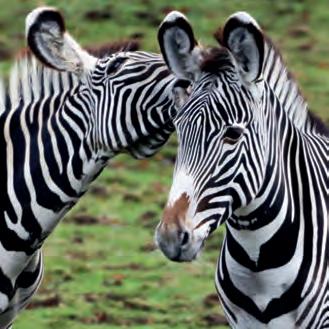
Also known as: dazzle, herd
......,......,,._.._......,·......,. and • are the three Grevy's zebras at Edinburgh Zoo. Grevy·s are the largest of the zebra family and their striking stripes are thought to help camouflage against predators and stimulate social grooming behaviours in groups.
Also known as: clowder
Highland Wildlife Park's Woodland Walk is home to lots of wildcats, while even more are cared for away from public view in the Saving Wildcats conservation breeding for release centre. At Edinburgh Zoo look out for wildcat residents . • and •
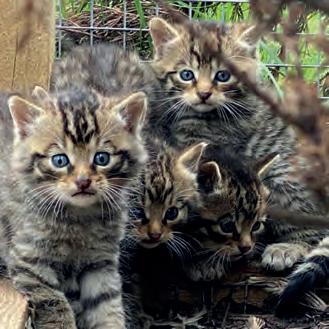
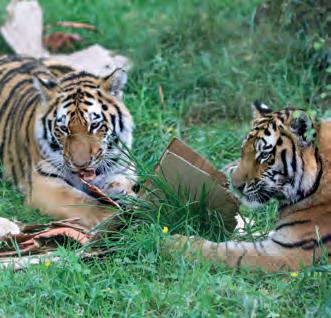
Also known as: hooting, stare, wisdom, congress
The father-daughter great grey owl duo, , and , , , can be spotted in their enclosure near Highland Wildlife Park's Woodland Walk. These skilled hunters are known to eat up to seven vole-sized mammals a day in winter.
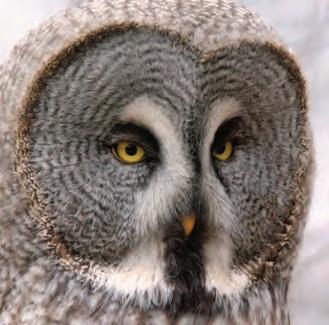
Also known as: bloat, herd, sea, school, pod, dale, crash, siege
As their name suggests, pygmy hippos are much smaller than the common hippopotamus. They have extremely sharp teeth that they use to crush fruit and strip vegetation. Two of these West African animals, • • and • , live at Edinburgh Zoo.
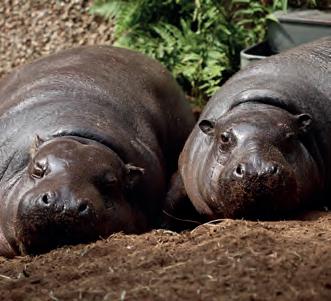
Also known as: flock, herd, scorn, train
Highland Wildlife Park's quartet of Bactrian camels are male and females . . • and • , , . They use their two back humps to store fat, have two rows of eyelashes to safeguard against sand and ice and can drink an impressive 55 litres of water at once.

Also known as: streak
Sporting striking orange and black striped coats, Amur tigers are the largest and heaviest of the world's big cats. They live solitary lives and use scent marking to establish territory. Highland Wildlife Park's Amur tigers, . and._,.:.;.!'=-i.i..i..11, ~=:.:: ,r:,n,.n_....,ri.._
ANIMAL COLLECTIVES
FOWL
RZSS.ORG.UK I WINTER 2023 17
''Idon't think I've ever known an animal like Nico," laughs Jess Brown, animal team leader of the animal experiences and displays team at Edinburgh Zoo.
Since arriving here in June, the four-year-old sloth -born and raised at the Isle of Wight's Amazon World Zoo Park -has made a big impression at his new home in the zoo's Sloths and Armadillos building.

Jess and the team were careful to give Nico opportunity to adjust to his new home, but he didn't take very long to settle in.
"We carefully managed noise levels, briefly closed the space daily to stagger visitor numbers, and kept a close eye on his behaviour while Nico adjusted to people wandering through his home,"
explains Jess. "Nico got used to seeing visitors every day quite quickly."
While acclimatising to curious visitors, Nico also had to learn to cohabit with the armadillos that share the enclosure, as well as with the zoo's other sloth, Feira, who has lived there since August 2021.
"We kept Nico and Feira in separate parts of the enclosure during his first night here so they had a bit of space to get used to one another," recalls Jess.
"But when we came in the next morning, Nico had somehow managed to make his way into Feira's enclosurea feat we're still baffled by today,
"They have got on great ever since. He's good at reading Feira's behaviour and gives her space when she needs it."
Weighing in at just 6kg, Nico is almost half the size of Feira. However, though he may be small in stature, his massively mischievous personality still fills up the room.
"Nico loves uncovering the enclosure's every nook and cranny. He'll twist and bend like a contortionist to get where he wants to go," says Jess.
"Recently we've trimmed some of the enclosure's trees and tall branches to stop him getting up to the roof. He seems to relish pushing the boundaries and surprising us at every turn!"
This sense of adventure never fails to enamour visitors to the Sloths and Armadillos enclosure.
"Nico blows everybody's mind when they see him. I always hear people remarking, 'Woah, I never thought

18 WINTER 2023 I RZSS.ORG.UK
sloths could do that!"' she laughs. "Teaching people something new about sloths on their trips to the zoo is one of Nico's most impressive feats. He's absolutely brilliant with the public."
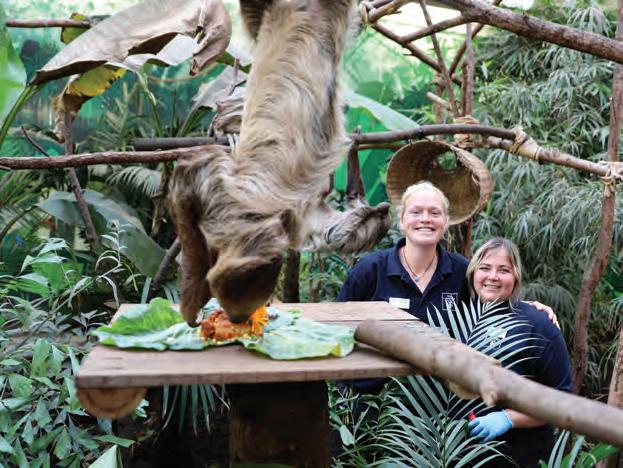
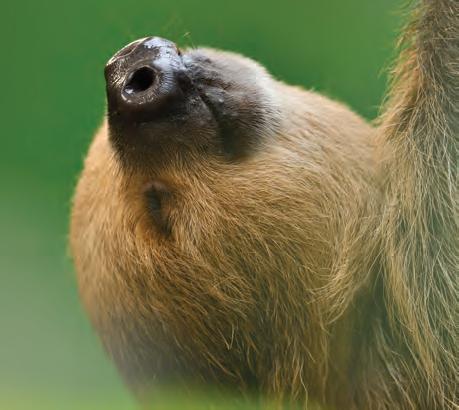
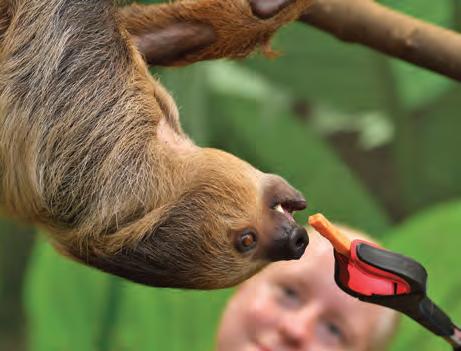

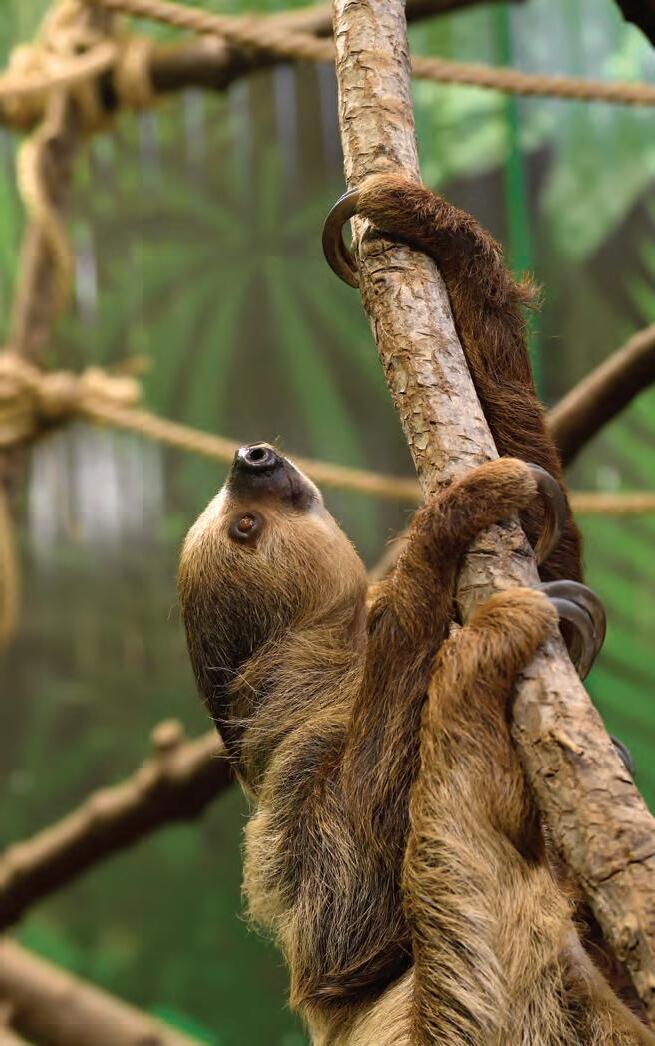
For Jess. Nico has also quickly become an important character in the keeper experience programme that her team runs at the Sloths and Armadillos building.
"Taking the big changes that come with moving home and meeting new housemates in his stride. Nico's slotted into life at Edinburgh Zoo impressively well -especially in such a short space of time," she says.

"Gentle and wild. fearless and curious. Nico's just a real sweetheart. And I can't wait to see what he gets up to
8:30am Nico snoozes while the team hose down the Sloths and Armadillos enclosure to get it to 80% humidity -the perfect level for sloths.
10am Breakfast time! Nico loves root vegetables -especially parsnips -which he munches 600g of daily.
10:30am Nico enjoys hanging from the enclosure's ropes to nosey at visitors trickling in.
11am Belly satisfyingly full, Nico climbs into his favourite sleeping box to catch some Zs.
3pm Feeding time again. Nico's favourite snacks are lilacs and leaves freshly cut by the zoo's gardens team.
4pm Nap number two. On chilly days Nico can be spotted coorieing by the enclosure's infrared heater.
5pm The end of another fun-filled day. Jess's team leave Nico fresh browse that he tucks into through the night.
11 He seems to relish pushing the boundaries and surprising us at every turn''
Jess Brown, Team Leader, Animal Experiences Team
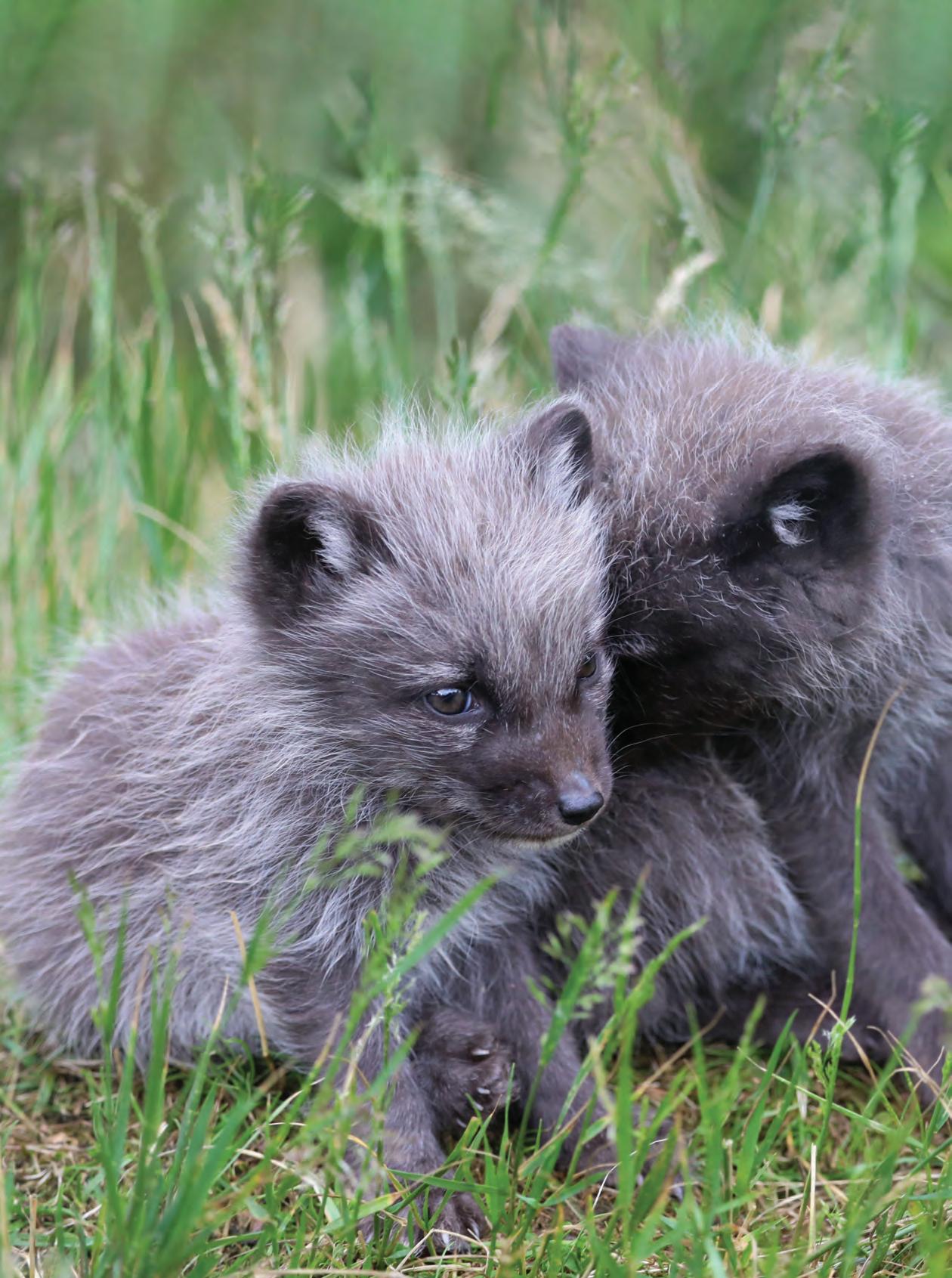
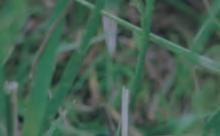
f you visited Highland WildlifePark this summer, you probably spotted a few of the park's newest arrivals. A steady stream of baby animals made their first appearances in the drive-through reserve and assorted enclosures through the warmer months, charming staff and visitors alike with their wobbly first steps and playful exploits.
Among the most endearing and popular were a litter of five cubs born to Arctic foxes Jack and Sarah. These five downy youngsters were something of a surprise! Long-term RZSSmembers will probably remember the last time Arctic fox cubs were born here: Sarah was one of that litter of 10 born in 2019 and stayed at the park after her siblings left. Young male Jack came to join her last year but, as he was only around six months old when he arrived, keepers were unsure whether he was ready for fatherhood.
"We didn't really expect anything to happen this year, but we always keep an eye on our animals anyway," explains senior carnivore keeper Judith Bowman. "There was a lot of burrowing going on -and that is normal for foxes -but then we noticed that Sarah was hiding away a little more than usual. We think the pups were probably born around 9 May, because that day Sarah disappeared for a full day."
It usually takes a couple of weeks for newborn fox cubs to emerge from the underground burrow in which they're

born. For the first few days, the team would spot Sarah popping her head out briefly and then disappearing back underground. She started to emerge for longer periods but still there was no sign of any cubs. And then, finally...
"Allof a sudden we saw some little faces!" remembers Judith. "Atthat stage they were just tiny balls of fluff that fitted in the palm of your hand, with tiny little legs. As there's nice high grass in the enclosure and they were still learning to walk, there was a bit of tumbling over as they made their way around."
To start with, the cubs only really emerged at feeding time, but by nine weeks they were fully weaned, eating
meat and growing fast. Around that time, staff also had the opportunity to check the cubs over and give them their vaccinations. "This is going to sound really unprofessional, but it was the cutest job ever," admits Judith. "Everyone wanted to help."
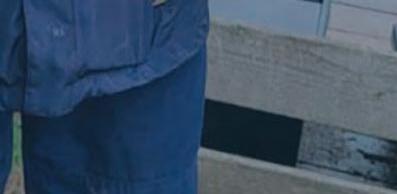


Soon, those little balls of fluff were making their carnivorous personalities felt. "There's a lot of feistiness between fox cubs," says Judith. "When you show up with their food there's plenty of noise and scrambling. They're all over each other because everyone wants to have their first bite. And we scatter-feed the food across the enclosure, so if one finds a bigger piece of meat the others will want it too."
Many markhors!
It's important not to handle carnivores such as Arctic foxes too soon after they're born, to avoid human scent rubbing onto the animals' fur and potentially leading their parents to reject them. They also have very sharp little claws and teeth. But some of Highland WildlifePark's animals have their first contact with keepers and vets at a much earlier age -and for very good reason.
Turkmenian markhor are a species of wild goat native to the mountains of the Hindu Kush. At Highland Wildlife Park, they live in two enclosures up the hill, close to the snow leopards. Kids are usually born overnight and discovered
by keepers the next morning, at which point the birthing protocol kicks in. "We need to catch these babies that day or the next one to tag them," says Highland WildlifePark hoofstock and wolves team leader Morag Sellar."We also chip them, and our vets will check them over and give them various inoculations. If we don't do all that within the first day or so, they're away up the rocks."




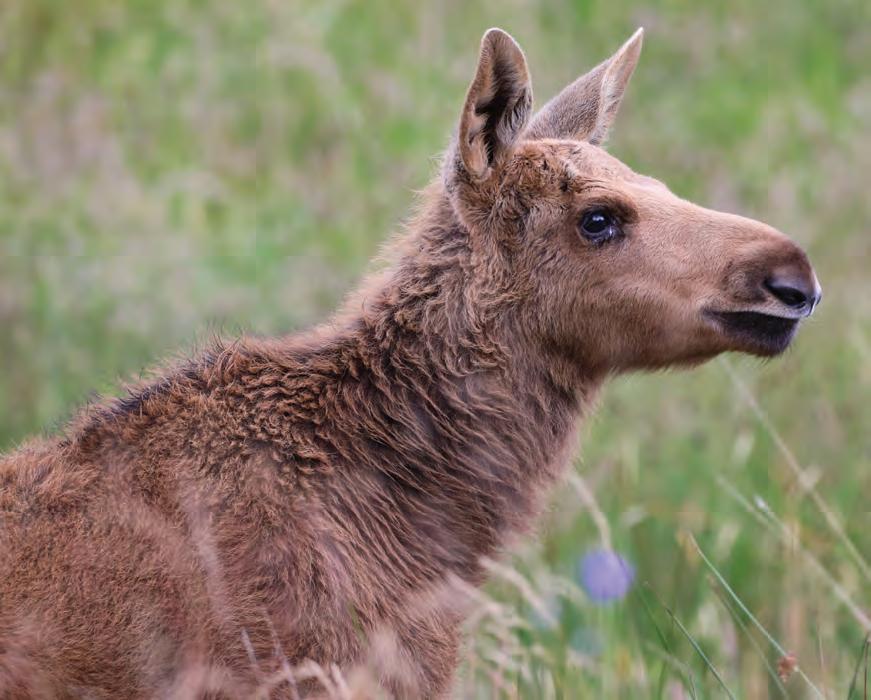
Two males and five females were born at the park this summer: Basil,Hemlock, Daffodil,Sorrel, Birch, Sweet Pea and Iris. As playful as any goat kid, they enjoy skitting around with each other but also remain close to their mothers while they're young. In fact, mother and daughter markhors often retain a close relationship -but when the boys are big enough, they'll either be moved on to
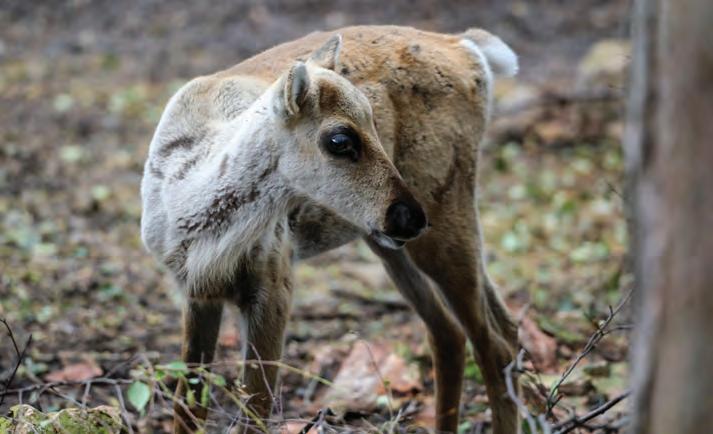
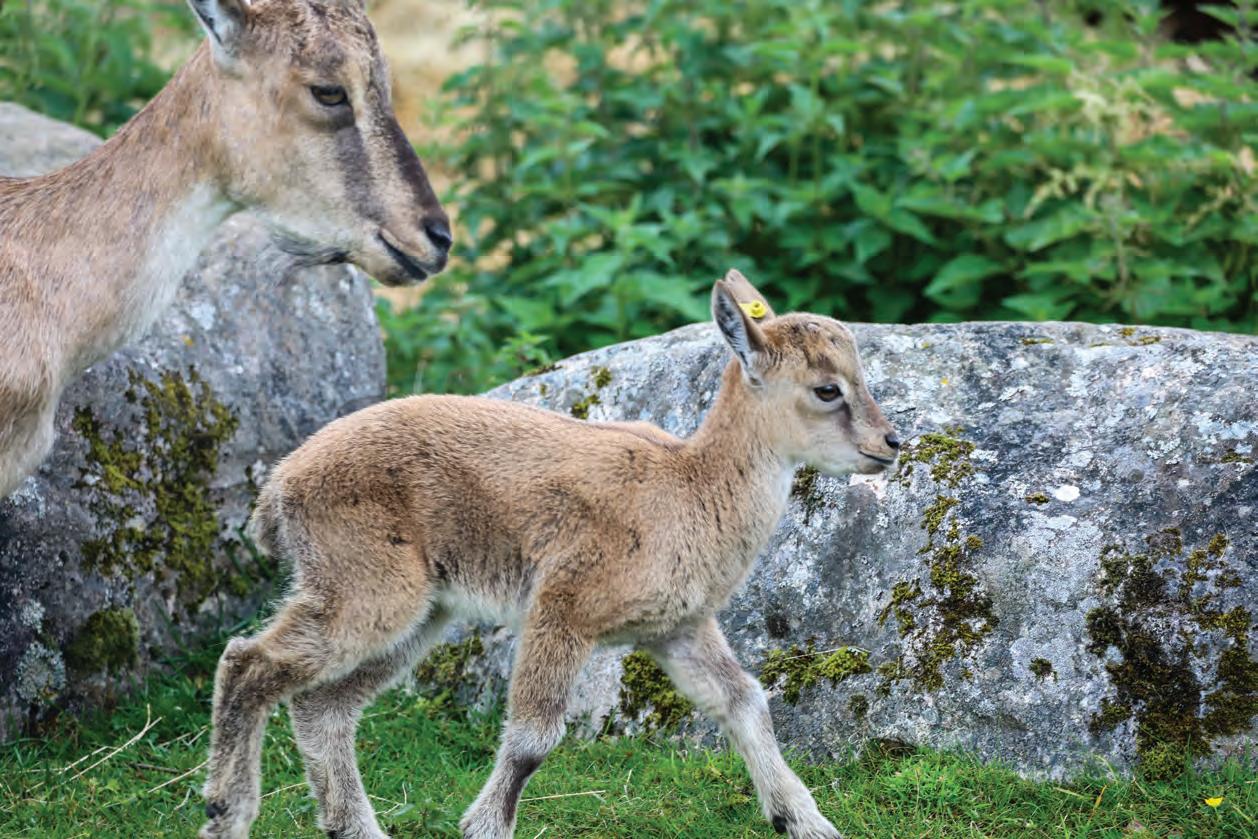
new homes or will join the other males in the second paddock.
The only other time when the male and female markhors mix is during breeding season -and even then, only one of the males (Moss) is let in with the females, because the others are too closely related. Until last breeding season, it had been a while since Moss had paid a visit because there was already a relatively large number of markhors at the park. These are also the only ones in the UK,so it's not always easy to find new homes for themparticularly since Brexit,due to red tape complications around animal transfers.
So, Sweet Pea, Sorrel, Basil and the gang may be here for a while at least... and Moss won't be entering the females' paddock this year. Thankfully, the enclosures are a good size and there's plenty of room for the existing animals, including the youngsters. "But it's an awful lot of poo-picking!" jokes Morag.
Different decisions are taken for each species, according to the makeup of the animal group and the advice of international species studbook keepers, who are responsible for managing

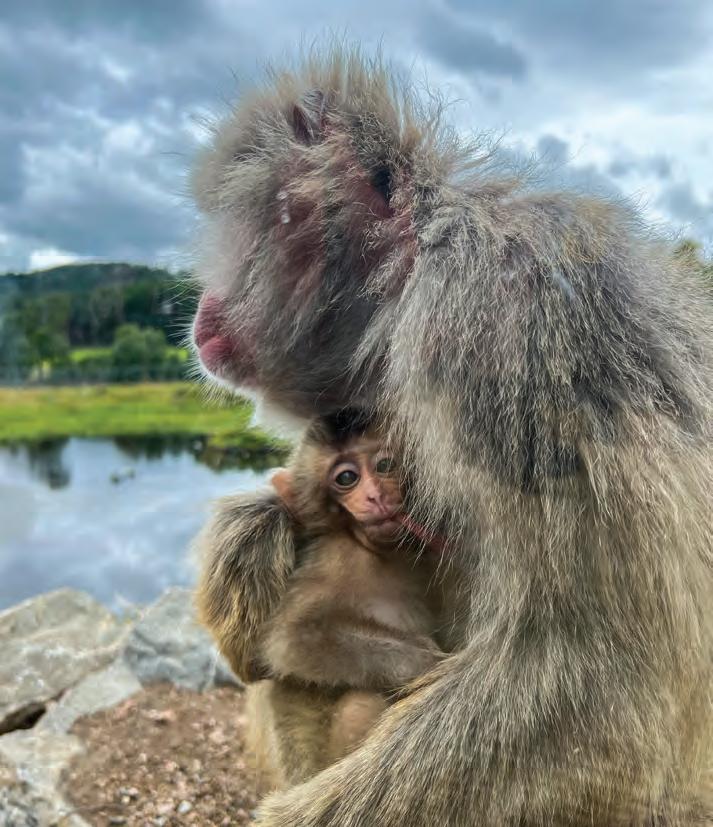 Senior Carnivore Keeper Judith Bowman on our Arctic fox cubs
Senior Carnivore Keeper Judith Bowman on our Arctic fox cubs
records and advising on animals' genetics. Breeding is not always as simple as leaving the animals to get on with it -but as long as the circumstances are right, keepers love to see the park's animals have the opportunity. "There's nothing more natural than for a female to have her calf or lamb," says Morag. "It'sthe most joyous occasion -you can see the female, she has fulfilledher aim in life. It's just lovely!"
Deer little calves
In the main reserve at Highland Wildlife Park, one of this year's first-time mothers was elk Ash, who had twins with partner Raven. Calves Goose (male) and Wren (female) will continue


to hang out with mum until they're about a year old, at which point there's a chance one or both might move on. But there's plenty of room to keep them here too, even if Ash has more calves next year.
Thankfully, their parents have taken well to parenthood and are also comfortable in each other's company, which is not always the case with this species. "In the past we've had females that will chase the male the length of the paddock and he's not allowed anywhere near the babies, but Ash and Raven are a great pair," says Moragadding that Ash is a fantastic mother.
Over in the reindeer paddock, beyond Wolf Wood, Sven and Freya welcomed their second daughter Kesa in 2023. Reindeer are the only species of deer in the world in which both males and females have antlers -but not every individual does so. While Sven grows a majestic pair of antlers every year, neither Freya nor elder daughter Lumi have them. Head keeper Morag thinks she can see antlers coming through on Kesa, so it will be interesting to see if she grows any next year.
11 They were just tiny balls of fluff that fitted in the palm of your hand"
Among other deer species, such as Highland WildlifePark's Bukhara deer (who welcomed youngster Be\'cher to the herd this summer) the dominant male in a herd will always father the young, keeping other males away from the females in breeding season.
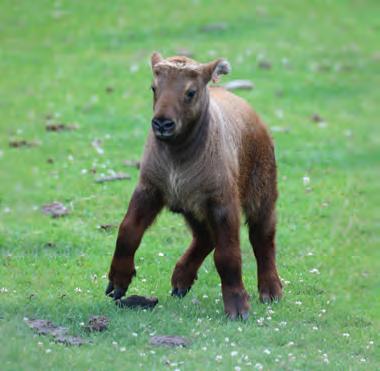
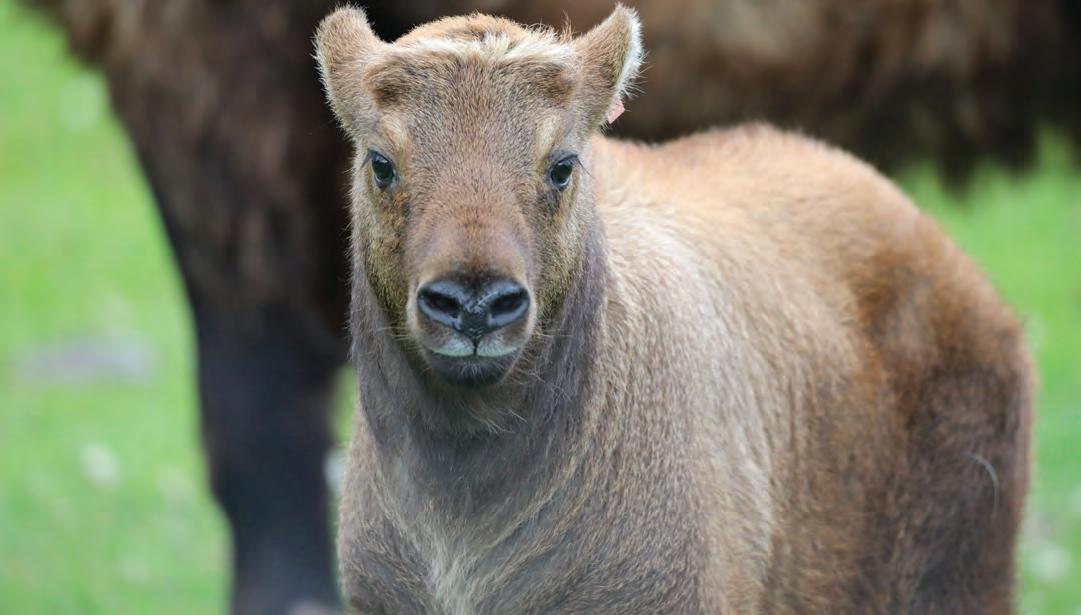
As a bull reindeer, Sven will not tolerate other males in his paddock and two previous males were rehomed at Whipsnade Zoo. Eventually, Sven too will probably move on. To avoid another calf too soon, he will be kept apart from Freya during this year's season. Then, as his daughters will start to come into season in coming years, it's likely that he will be found a new home.
"When an animal moves on, it's no bad thing -it means we've done things right. There's a great deal of thought that goes into it," says Morag. "Andwe know that the new place will be vetted."
Different baby animals have different needs when it comes to how long they stay with their mothers. This year's Japanese macaque babies Oops, Osaka and Omashu were carried on their mothers' bellies for the first four weeks and may continue to be carried on her back for a year or more before they're fully independent.
And the five kittens born to wildcat Talia are still with mum for now but will likely find new homes before too long.
11
Morag Sellar, Team Leader, Hoofstock and Wolves
Next steps
In the wild, Arctic foxes will leave their family group by the time they're four or five months old -so, by the time this magazine arrives on your doorstep, four of Jack and Sarah's cubs may have moved on, having already secured homes. But one of the females, Toots, will stay at Highland WildlifePark with her parents, just as her mum did.
In the meantime, keepers are looking towards next season. Back in the drive-through reserves, a stallion joined the herd of Przewalski's horses this year and has been settling in well. The herd didn't previously have a breeding male, so Morag Sellar is optimistic that there'll be foals in 2024.
Any new youngsters will help contribute to the future of this endangered species and act as a poignant reminder that the Przewa\ski'shorse, the only truly wild
horse in the world, was extinct in the wild 50 years ago.
The eventual reintroduction of Przewalski'shorses to their natural environment, including their native Mongolia, was thanks to the efforts of the worldwide zoo community. That success story shows just how important a carefully managed captive population is to safeguarding the future of our wild animals.
"There's always potential to contribute towards the wild for any species," says Morag Sellar."Our role as keepers is to care for them and make sure they've got the best
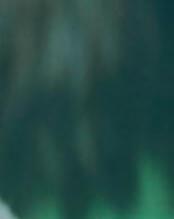
24 WINTER 2023 I RZSS.ORG.UK
11 There 1s nothing more natural than for a female to have her calf or lamb


























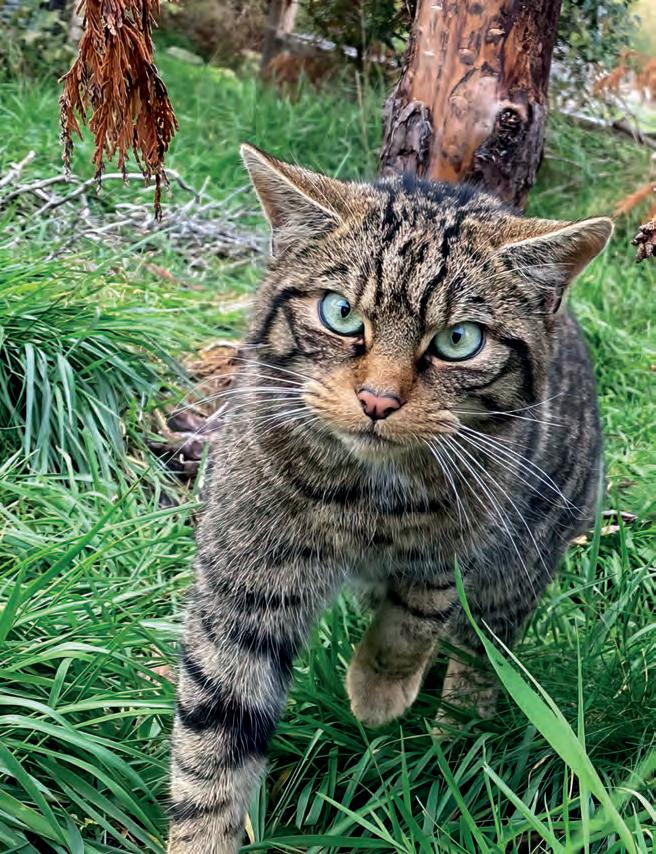
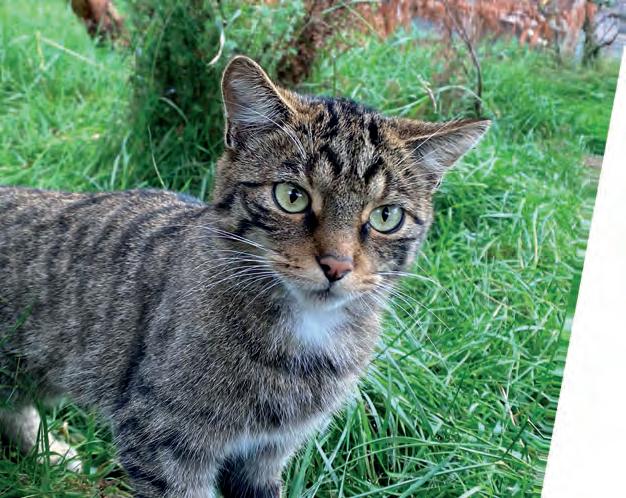

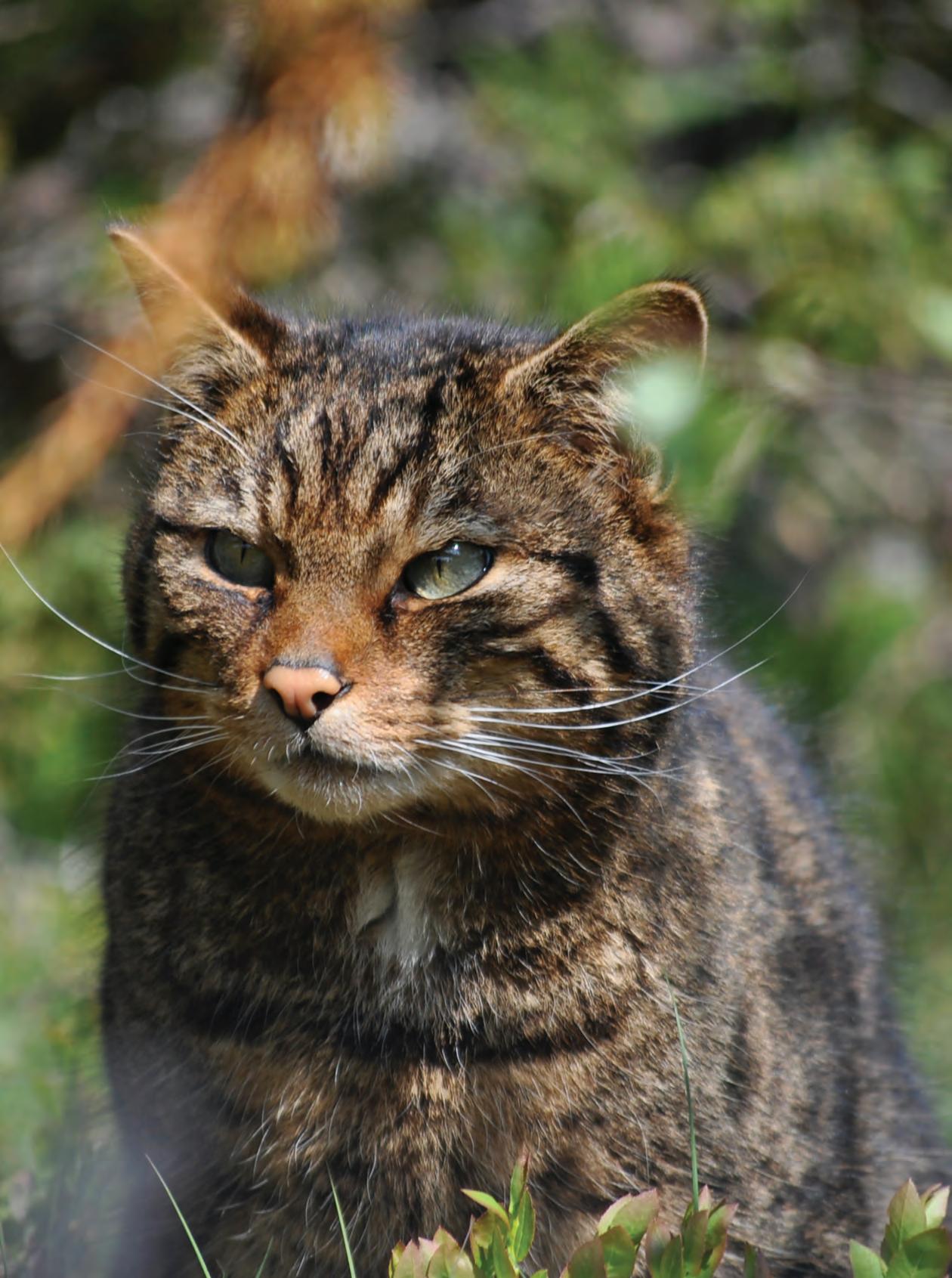
hen members of the Saving Wildcats team released cats into an area within the Cairngorms National Park in June, they could be forgiven for a collective intake of breath. A milestone moment more than a decade in the making, it marked the first-ever conservation release of wildcats in Britain -with what happens next going a long way towards determining the future of a native species on the edge of extinction.
At first, the animals did not need to travel far. AUwere born last year

and raised in the Saving Wildcats S conservation breeding for release
centre in an off-display area at Highland
Wildlife Park. Ahead of their release
at natural dispersal age, the cats
were moved into larger pre-release enclosures to help them develop hunting, foraging, scent-marking and other life skills needed to survive in the wild. Then came the big moment, with the cats transported to carefully selected sites across the Cairngorms Connect area -a wild, sprawling landscape just across the River Spey from Highland Wildlife Park.
The largest habitat restoration project in the UK, Caimgorms Connect involves a partnership of neighbouring land managers all working towards a 200-year vision to enhance habitat, species and ecological process across a 600 square
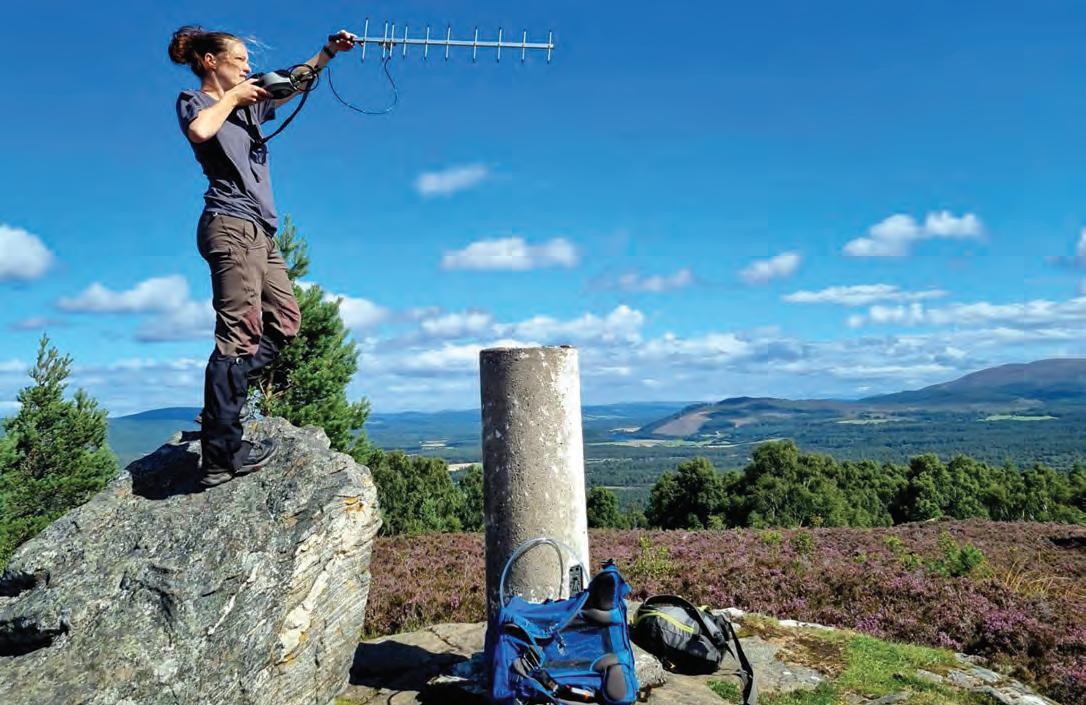
kilometre area. Meticulously considered, the area provides suitable habitat for the cats as well as the mix of prey -mostly mice, voles, rabbits and small birdsthat they need.
But scale and ambition are of equal importance when it comes to wildcats. ·we're talking about an animal with complex habitat needs that ranges widely, so it's important that we release into a site where there is a vision for habitat protection and restoration in the long term," explains Dr Helen Senn, Saving Wildcats project lead and head of conservation and science programmes at RZSS.
Since the first release, further cats have been translocated to the area. AUare fitted with GPS-radio collars that allow them to be closely monitored and tracked by an expert field team.
Meanwhile, the setting of more than 100 camera traps throughout the release
.,,
<.J
0
z
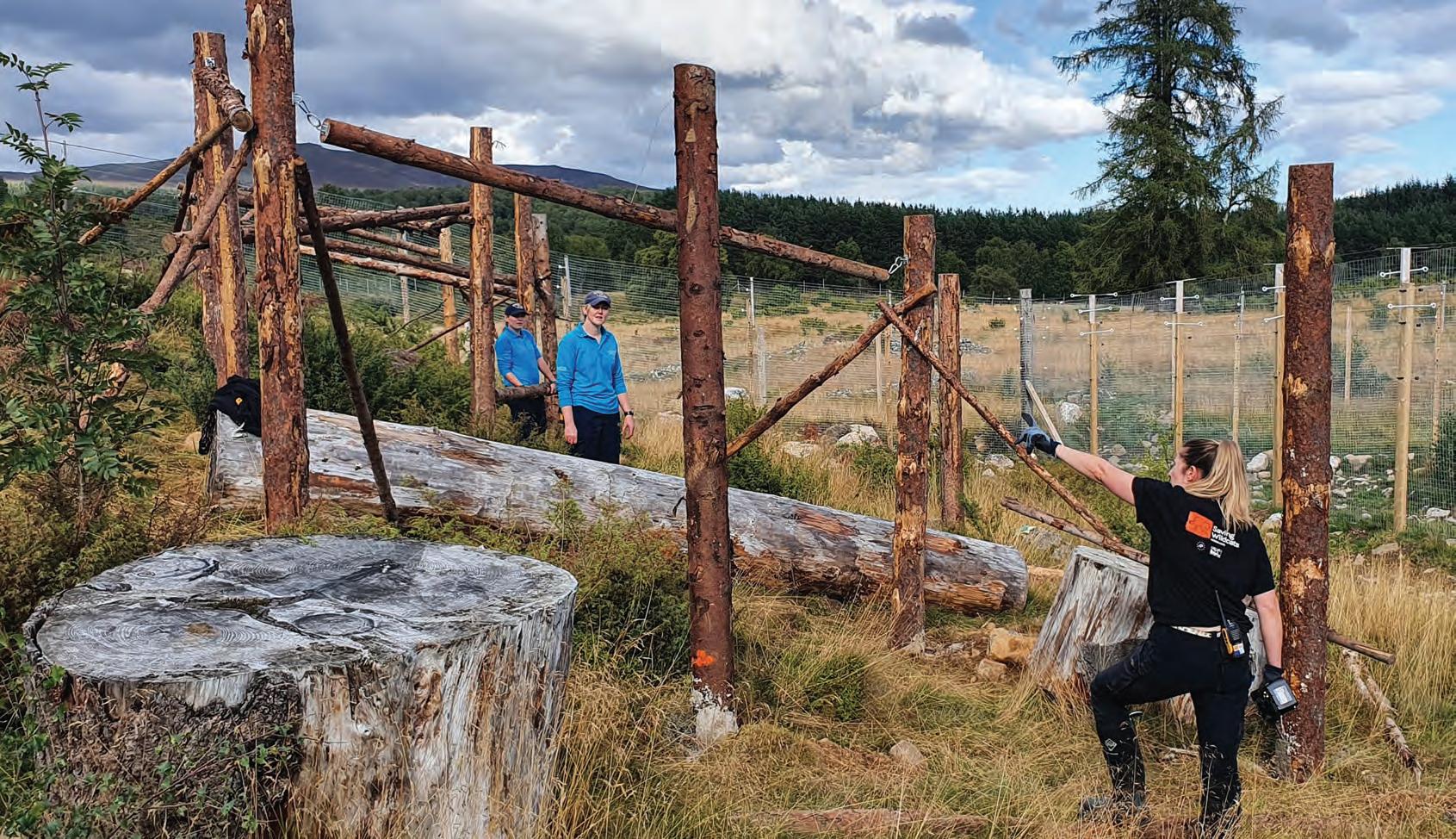
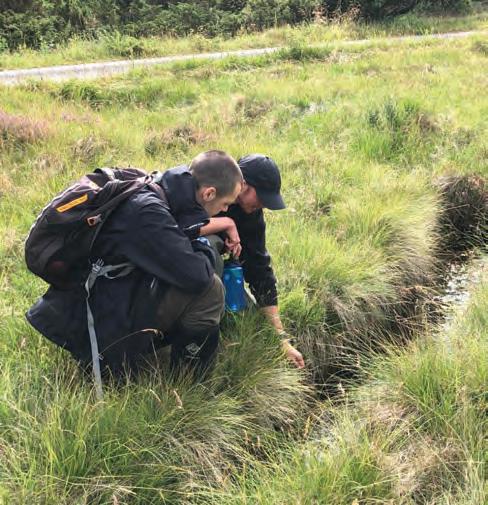
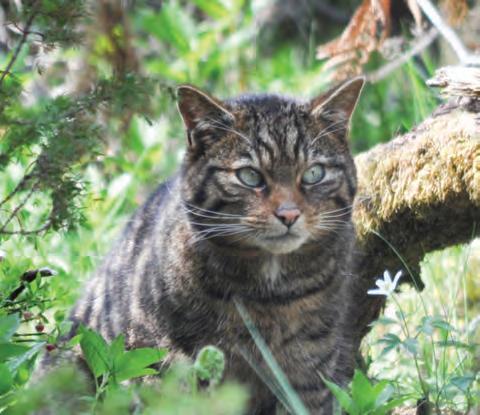

28 WINTER 2023 I RZSS.ORG.UK
site will generate millions of images that together paint a picture of life in the wild.
'The cats are mostly going where we anticipated based on the project's modelling," reports Helen.
"When working with a species on the brink of extinction there is often a degree of guesswork, but the great thing here is that the team has the ability to see the cats' movements and understand patterns of behaviour over time."
A new approach
It's hard to overstate the tremendous collective effort that has been involved in reaching this point.
The releases have only been made possible thanks to a large team at Highland WildlifePark, the project's many partners, plus the foundations laid and relationships forged over more than a decade of wildcat conservation efforts in the Cairngorms. RZSS was involved in an earlier Highland tiger initiative as well as another precursor project, Scottish Wildcat Action, which resulted in the first ever national conservation plan for the species.
CONSERVATION
Much of the initial focus of that project was on understanding what was going so badly wrong in the wild -chiefly habitat loss, human persecution and interbreeding (or hybridisation) with domestic and feral cats -and then working alongside local communities and landowners in wildcat priority areas to mitigate those threats.
"However, over time it became clear that there were really not many wildcats left in the wild at all,"explains Helen. "It was a classic case of counting the books while the library burns -a term often used in conservation when you monitor a situation but it just keeps getting worse."
Recognising the need for a change of tack, the Scottish Wildcat Action partners commissioned the IUCN Cat Specialist Group to undertake an independent review of the status of the species in Scotland and the conservation work done to date.
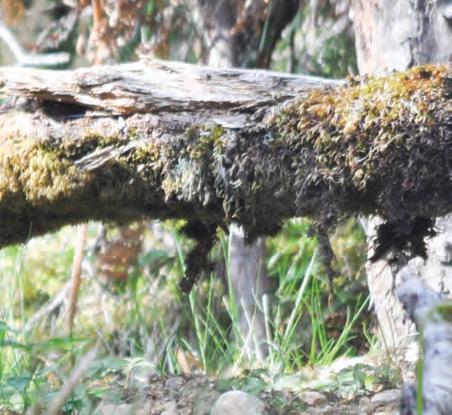
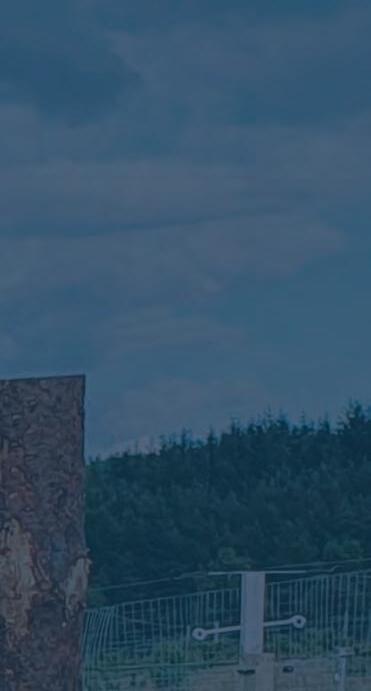
The review came to a stark conclusion: with remaining individuals spread so far apart, there was no longer a viable wildcat population living wild in Scotland, with hybridisation the primary threat to their survival.
Crucially, the report's recommendations signalled a step change in approach to wildcat conservation in Scotland, with one key intervention being the captive breeding for release of cats into areas where threats are heavily controlled. "Andthat's how the Saving Wildcats partnership project was born," says Helen.
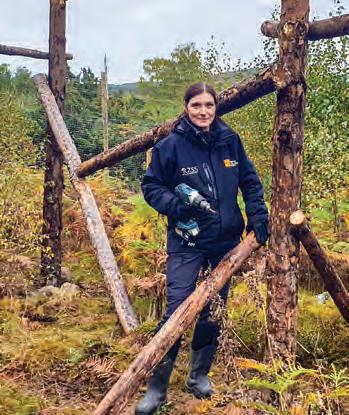
Conservation breeding
Here, the partners were one major step along the road. RZSShas a long history of captive breeding of wildcats at Highland WildlifePark, although key questions had to be answered about C) 11

11
The team has the ability to see the cats
1
movements and understand patterns of behaviour over time
RZSS.ORG.UK I WINTER 2023 29
Helen Senn, Head of Conservation and Science Programmes
levels of hybridisation and genetic diversity in that captive population.
Many of the animals were also on show to the general public. 'That's great for enabling people to learn more about them but it doesn't make for good release animals," notes Helen.
When RZSStook over the studbook for the species in 2015, it was able to gradually increase the number of animals in captivity from 60 to more than 150 cats. It was also able to analyse every individual from a genetic perspective. This was hugely significant as it helped inform future breeding decisions to ensure that the best possible matches were made to create a genetically diverse population.
Under special licence, RZSSwas also able to bring in wildcats from areas where there was limited potential to protect them in the wild -so adding further diversity to the gene pool.
Earlier this year, the Saving Wildcats partnership welcomed 13 kittens in five litters, with all kittens likely be part of releases scheduled for 2024.
Best practice
To further understand wildcat ecology and behaviour, the partnership has drawn on leading conservation efforts elsewhere. In particular, the release programme is heavily influenced by

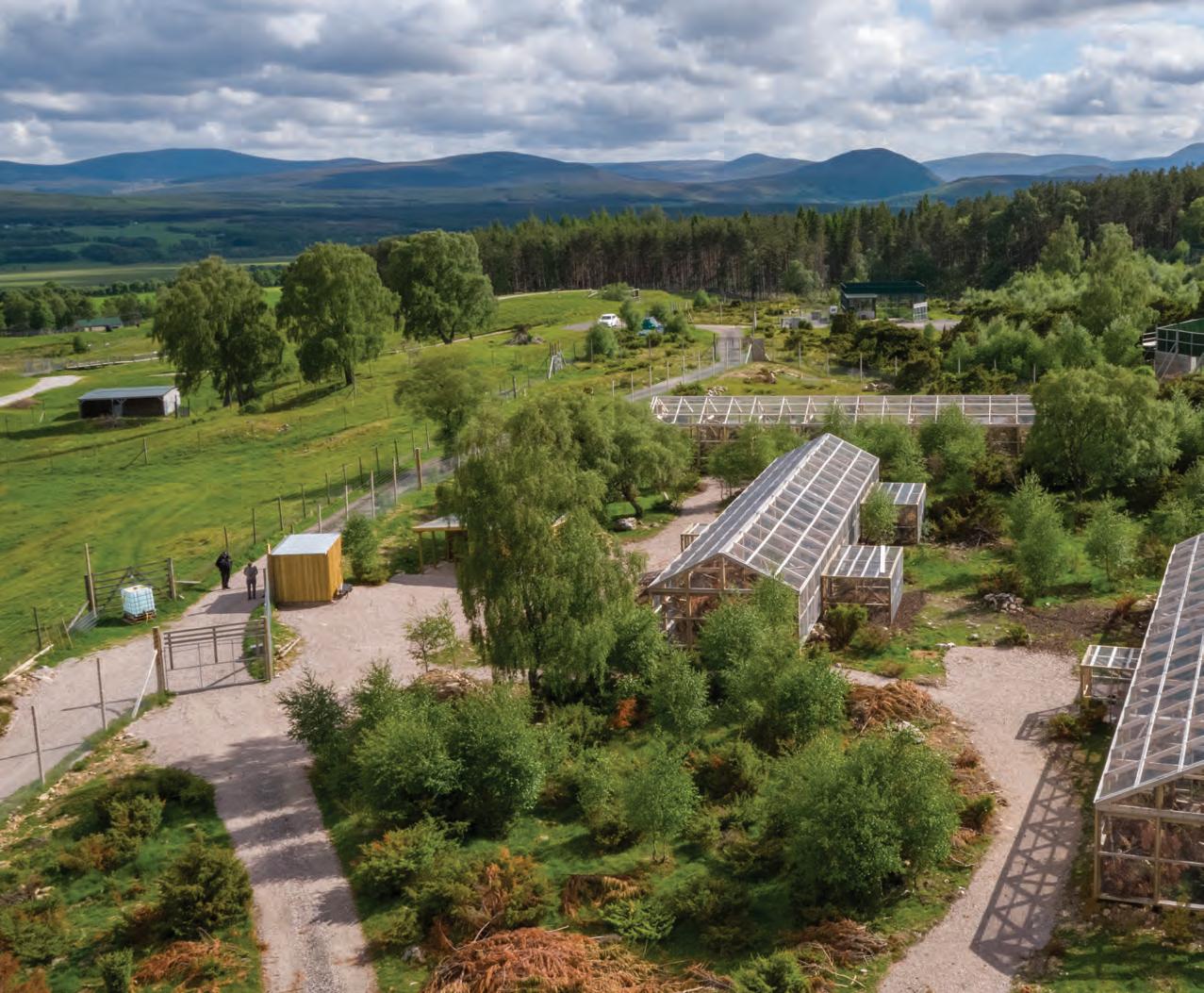
11Life in the wild is hard for carnivores so we knew that we needed a concerted1 multi-year plan 11
Helen Senn, Head of Conservation and Science Programmes
the Iberian Lynx Project, a breeding for release initiative in Spain and Portugal which is widely considered one of the most successful of its kind in the world.
One key component of the lynx project is a breeding model that sees cats bred. raised and prepared for life in the wild off-show. with very limited contact with humans.
"It also has a real vision for doing this at scale," notes Helen. "Lifein the wild is hard for carnivores so we knew that we needed a concerted. multi-year plan."
Following the release of wildcats this year. the ambition is for an additional 20 individuals to be released in each of the next two years.
"Our modelling tells us that releasing a total of 60 cats over a three-year period gives an appreciable chance of having a viable population in the long term," explains Helen.
It's estimated that wildcats experience around a 70% mortality rate during the first year in the wild -a somewhat startling figure that the team hope will be lower given that the release animals have spent their first year in captivity.
Even so. the expectation remains for a relatively high mortality rate.
"It's important to say that mortality of individual cats does not necessarily mean that the project has failed, but it is something that we will keep a very watchful eye on through our monitoring," says Helen.

"It might be that we are actually hugely successful or we have a couple of really hard winters. There are lots of variables that we have no control over."
Cat culture
For many people living and working close to the release area, wildcats are deeply ingrained culturally. They appear on the Coat of Arms Crest of the Clan Macpherson and on the badge of the local high school, and are the subject of a dedicated trail that guides walkers around the village of Newtonmore.
This perhaps explains why the response to the project partners' engagement with local communities and landowners in and around the release site has been broadly positive. "There is a cultural appreciation that wildcats are meant to be here," says Helen.
Such backing bodes well for the success of the release phase of the project, but the team knows full well that it will take much more than goodwill and understanding if populations of this almost-lost predator are to return
to viable numbers. So. what would success look like?
"For us to learn much more about wildcat survival would be one success criteria. but really what we want to see is the cats reproducing to the point where the population is self-sustaining," explains Helen.
Although the team has its own predictions, quite what number of individuals it will take for that to be the case is impossible to say until the cats have been monitored over a period of time.
"If by the end of the project we see kittens being born in the wild as a result of what we are doing, then we'll be on the right track," says Helen.
And the ambition doesn't end there. The ultimate success story would be for wildcats to be restored across larger tracts of Scotland. "If it were to be successful here in Cairngorms Connect, then in future we would look to expand the population into other areas. but that's a major. long-term effort."
One thing is for sure. many eyes are on this project -and not just in Scotland. "Ultimately, it might even spark something bigger, including supporting reintroductions in Wales and England. which are both being talked about," adds Helen.
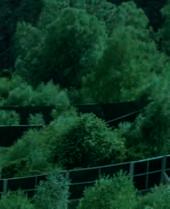

SAVING WILDCATS
The Saving Wildcats project is led by RZSS in collaboration with NatureScot, Forestry and Land Scotland, the Cairngorms National Park Authority, Nordens Ark, Junta de Andalucfa, and with releases being conducted with the support of Cairngorms Connect. We are very grateful to our funders and supporters, including the LIFEprogramme of the European Union and everyone who has sponsored a wildcat (find out about sponsorship on page 47).
CAIRNGORMS CONNECT RZSS.ORG.UK I WINTER 2023 31
SAVING WILDCATS
NEAREST AND DEEREST
A family of four European forest reindeer lives in Wolf Wood at Highland Wildlife Park. Sven and Freya arrived in 2017, and these days their herd includes daughter Lumi and her younger sister Kesa. In Finnish, Lumi means snow and Kesa is the word for summer -the park has a tradition of giving calves weather-inspired names.
LEGGING IT
At first glance, it's easy to mistake these animals for common or domestic reindeer, but they are, in fact, a subspecies. European forest reindeer are bigger, have longer legs, and their antlers are narrower, too. These differences help the reindeer to survive in the snowy boreal forest (or taiga), with its overhanging branches and deep drifts.

BACK FROM THE BRINK
This subspecies is much rarer than domestic reindeer. Also known as Finnish forest reindeer, they can be found living wild in northwest Russiaand, you guessed it, Finland, where they were actually hunted to extinction in the early 20th century. Happily, they began returning from over the border a few decades later.
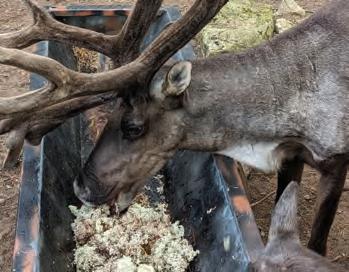

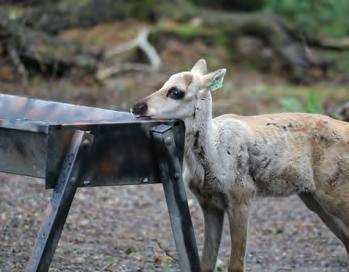
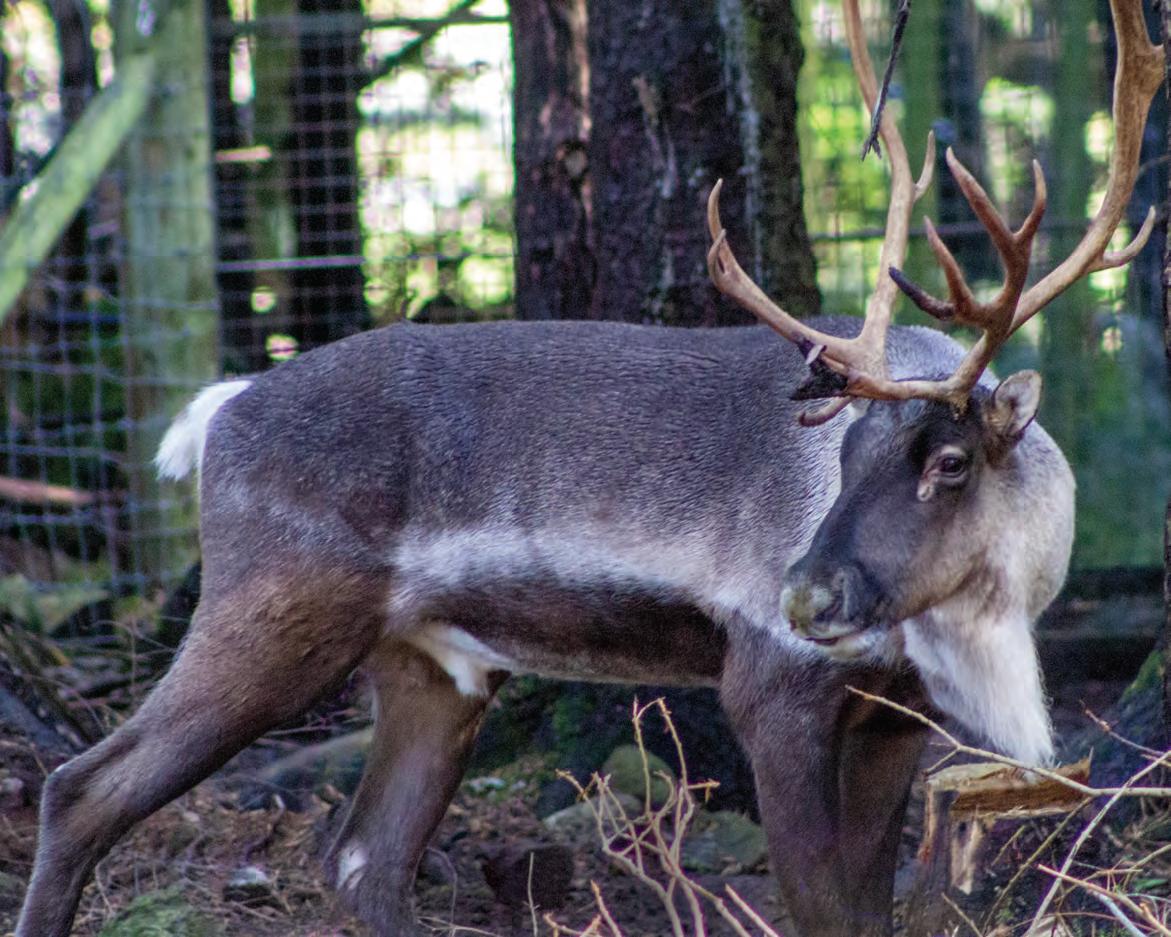
These furry forest dwellers are built to beat the worst weather that the wild taiga can throw at them
32 WINTER 2023 I RZSS.ORG.UK
SEETHE LIGHT
Research has found that reindeer can see ultraviolet light. They are thought to use this unusual skill to their advantage when searching for food and keeping watch for such predators as wolves, lynx, bears and, perhaps most dangerous of all, people. Poaching, collisions with cars and snowmobiles and increased tourism are all threats to their survival.

FANCYFOOTWORK
Freezing conditions are no problem for the wide and rather hairy feet of the European forest reindeer. Not only can their huge hooves confidently carry them through snow, but the fur that sprouts between their toes stops slush building up. Ahead of harsh winter weather arriving each year, those hooves become tough and sharp, ready to break through ice with ease.
FURRYGOOD
European forest reindeer have darker, more uniformly coloured coats than common or domestic reindeer. However, all reindeer have two layers of fur for ultimate warmth, with a fine woolly undercoat covered by an insulating blanket of coarser, longer hairs.
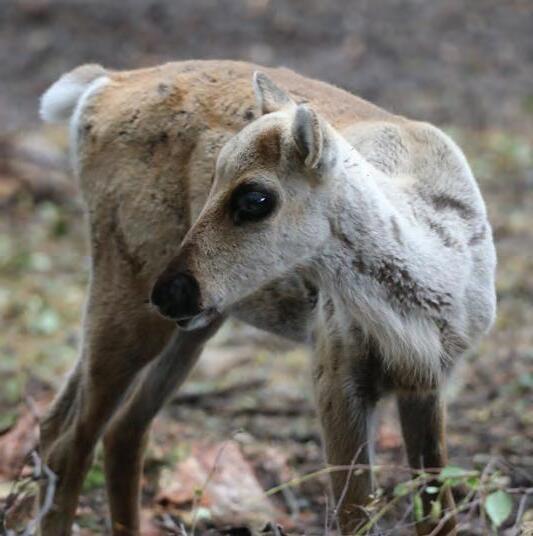
TIMOROUS BEASTIES
Thanks to Highland Wildlife Park, you probably have a greater chance of spotting a European forest reindeer in Kincraig than you would in Finland or Russia. People have to be really lucky to catch a glimpse of them in the wild -they're pretty shy, so lurking among the trees suits them just fine!
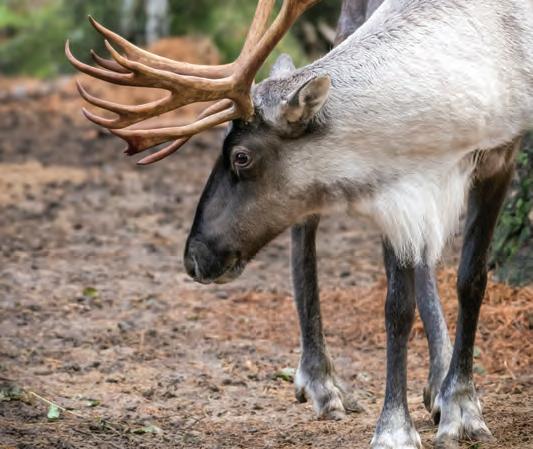

DID YOU KNOW?
RZSS.ORG.UK I WINTER 2023 33
The mob of male meerkats have an exciting new home
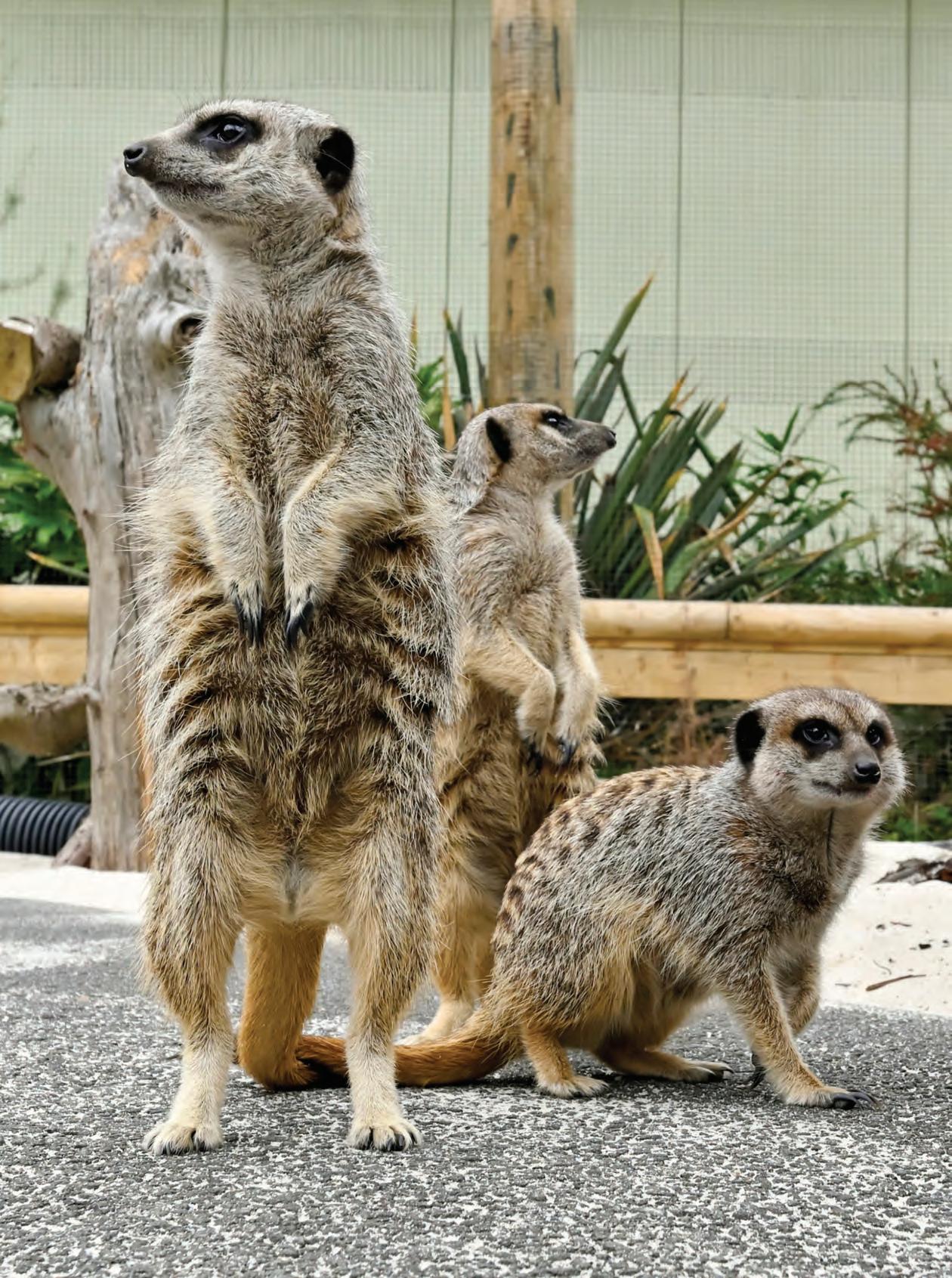
Gregarious, inquisitive and incredibly cute, it's easy to see why meerkats are universally beloved. Edinburgh Zoo is lucky enough to house two meerkat mobs -one group of females near the front entrance that regular visitors will be very familiar with, and a group of males that recently moved into an impressive new enclosure built specially for them, where visitors can get up close on the zoo's experience days.
Brimming with meerkat-like curiosity, I visited this summer to learn what makes the new domain perfect for meerkats -and also to hear about a pioneering partnership between the Royal Zoological Society of Scotland, Edinburgh Children's Hospital Charity and NHS Lothian.
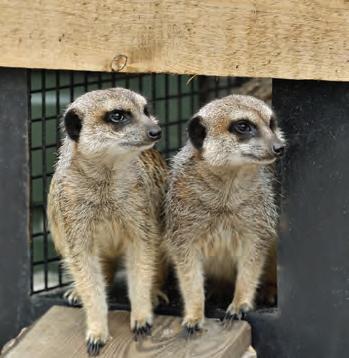
Ace and the gang
The sun is shining when I meet friendly animal experiences lead Erika Oulton. During a 25-year career at Edinburgh Zoo, Erika has looked after many different animals, from primates to penguins. Today, she oversees the animal experiences team: a 12-strong crew delivering tours and once-in-alifetime experience days that let visitors get up close to the zoo's residents, including lemurs, sloths and meerkats.
"Myrole involves connecting people with nature and ensuring the animals are happy, safe and well looked after," explains Erika as we get ready for the day ahead. "During experience days, visitors join me on my daily routine. It's really enriching for the keepers and animals because you hear people's amazing stories and passion for the species we look after here."
Erika'sjob also involves pinpointing which of the zoo's animals are suited to the keeper experience programme. One group that perfectly fit the bill was Edinburgh Zoo's male meerkat mob.
The leader of this group is the zoo's eldest meerkat, 16-year-old dad Ace,
then there's Boots, Stanley, Jim and The Grinch -four of whom gained their monikers from Jim Carrey roles. Since moving into the experience enclosure at the Sloths and Armadillos building, the group has settled in nicely. And as Erika ushers me into this new meerkat mansion, I can see why it's the perfect fit for these charming creatures who are intently assessing their latest visitor.
"The new experience enclosure is amazing, especially its outdoor section," says Erika."Itssmall central garden and encircling sandy pit are really enriching for the meerkats because they experience different textures and smells when digging them out. The area also has heat lamps that the mob nestles under together on chillier days and wooden posts of different heights that they sit atop to watch the world go by."
Thanks to the enclosure's outdoor space, Erika and the team have witnessed Ace's mob exhibit new behaviours -including acting as sentries to alert one another to happenings in the sky above. The enclosure's design has also widened access to the keeper experience programme.
"Many visitors to the programme have additional support needs, which is why this enclosure is fully accessible," says Erika.
MEERKATS
RZSS.ORG.UK I WINTER 2023 35
"We're also hoping to increase daily visits. Currently, we time the keeper experience visits to coincide with one of the meerkats' four daily feeds. Now we're working alongside the zoo's discovery and learning team to bring in more school groups and teach them all about these tiny mammals."
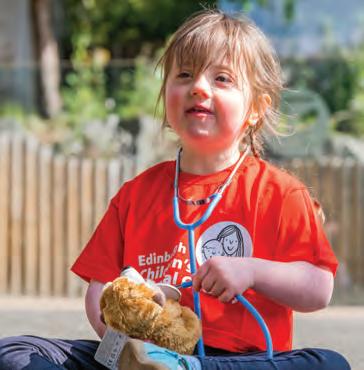
With meerkats ranking among Edinburgh Zoo's most visited animals, this new experience enclosure is a great way to engage audiences further.
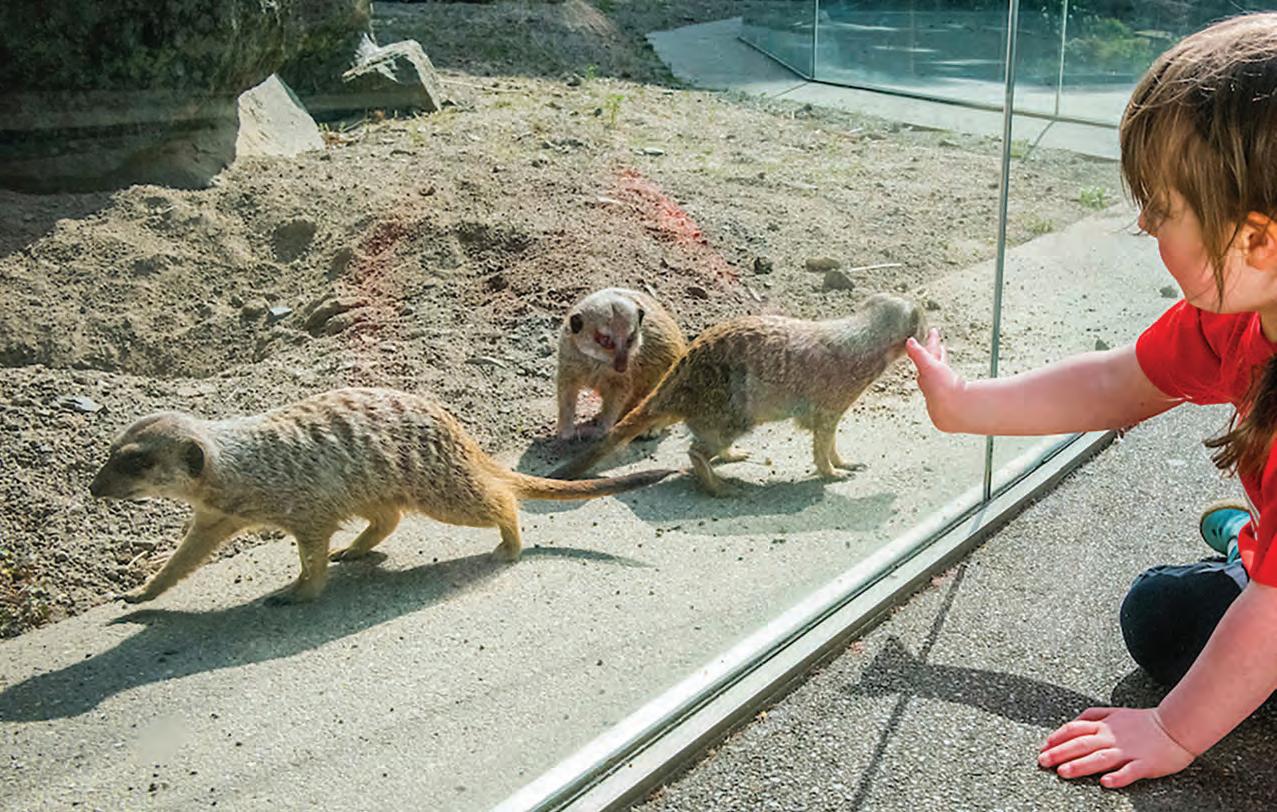
"Youcan't deny that their cuteness and characteristic curiosity are just a few of the many qualities that make meerkats universally appealing. Plus, their natural nosiness is very similar to human behaviour, which makes them really relatable," says Erika.
"But there's so much more to these animals. They're incredibly intelligent and live in complex societies where they have distinct roles. Their antics make them so interesting to watch."
Out into the community
It's this ability to enamour visitors that's made meerkats major players in Edinburgh Zoo's partnership with Edinburgh Children's Hospital Charity and NHS Lothian, which will see a new enclosure built at the Royal Hospital for Children and Young People's Castle Mey courtyard in 2024. As I say cheerio to Erika and leave Ace's mob snoozing in the sun, I meet Ben Supple, director of engagement and business development at RZSS,to learn more about this community engagement project.
"Nature is for everyone, but we recognise that many barriers -

including poverty and poor physical and mental health -prevent people from accessing it. By collaborating with communities and charities, we can help tackle these challenges to increase access to nature," explains Ben. "This new partnership with Edinburgh Children's Hospital Charity is testament to this mission and will allow more young people to engage with, and learn more about, nature."
Established at the onset of the Covid-19 pandemic, Edinburgh Zoo's community
MEERKATS
36 WINTER 2023 I RZSS.ORG.UK
team have built successful partnerships with community-focused charities including Cyrenians and Age UK to help tackle homelessness and loneliness. This latest partnership is a bold new chapter in Edinburgh Zoo's long-standing relationship with the Royal Hospital for Children and Young People.
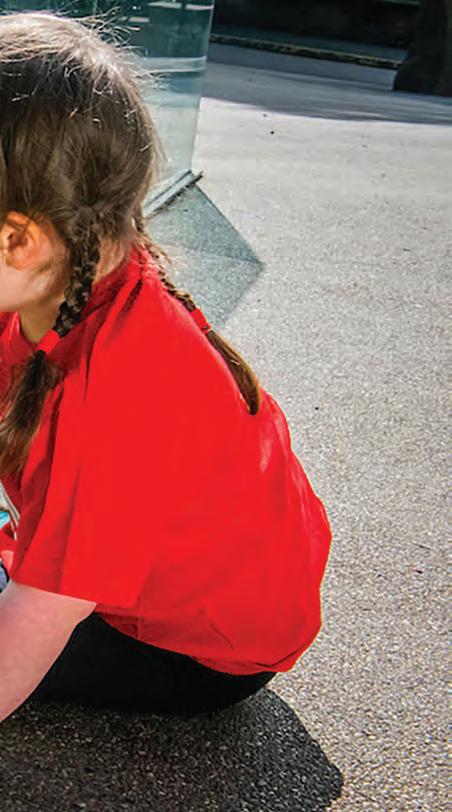
"It can be incredibly distressing for parents and guardians seeing young people unable to leave hospital and interact with nature. That's why we've always offered Edinburgh Children's Hospital's patients free access to the zoo whenever needed. This relationship expanded when we introduced our weekly nature education programme at the hospital run by one of our community officers. Young people love it because it lets them experience nature from their bedsides while thinking about their place in the world and the importance of wildlife A within it," says Ben. V .._ ___ _
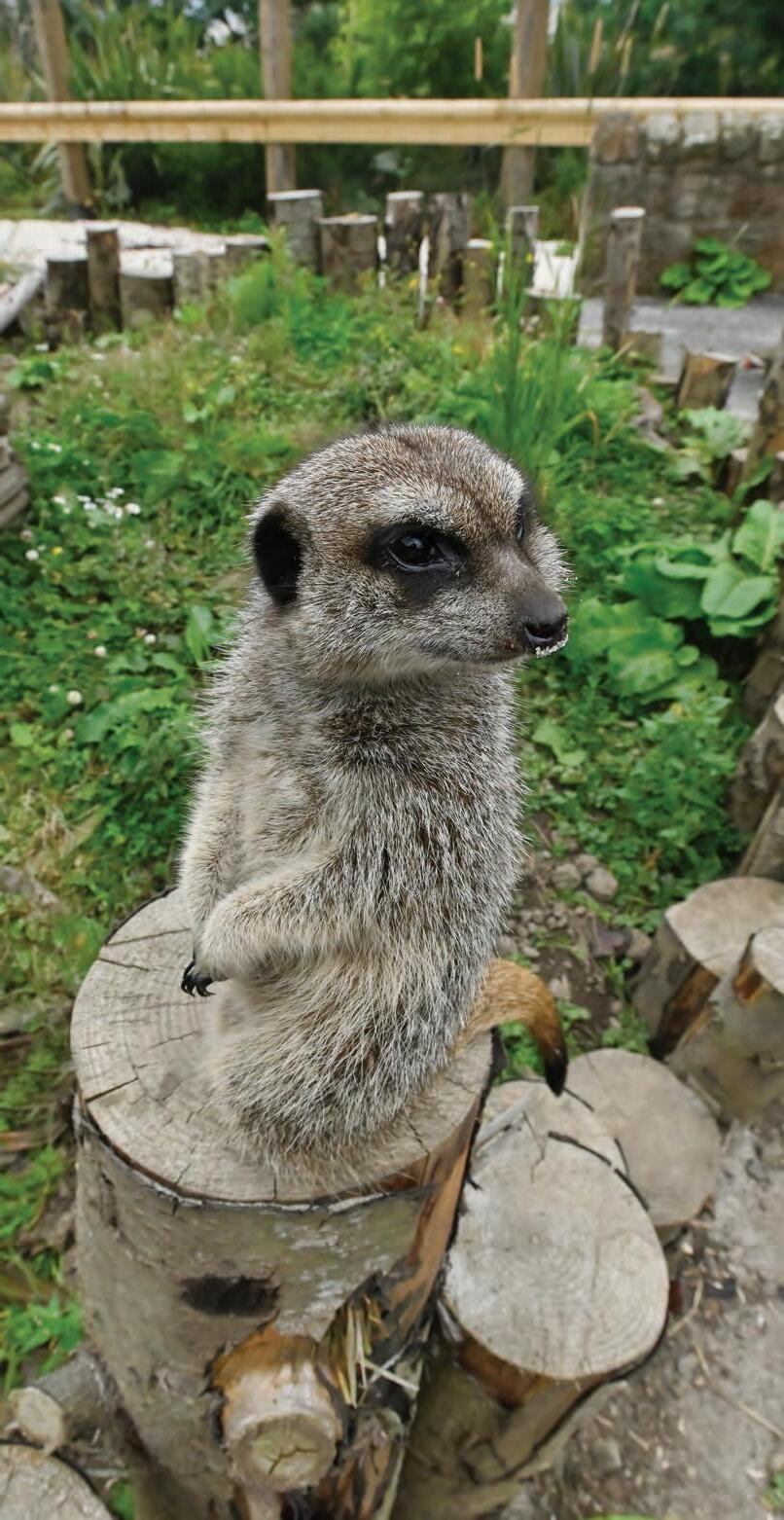
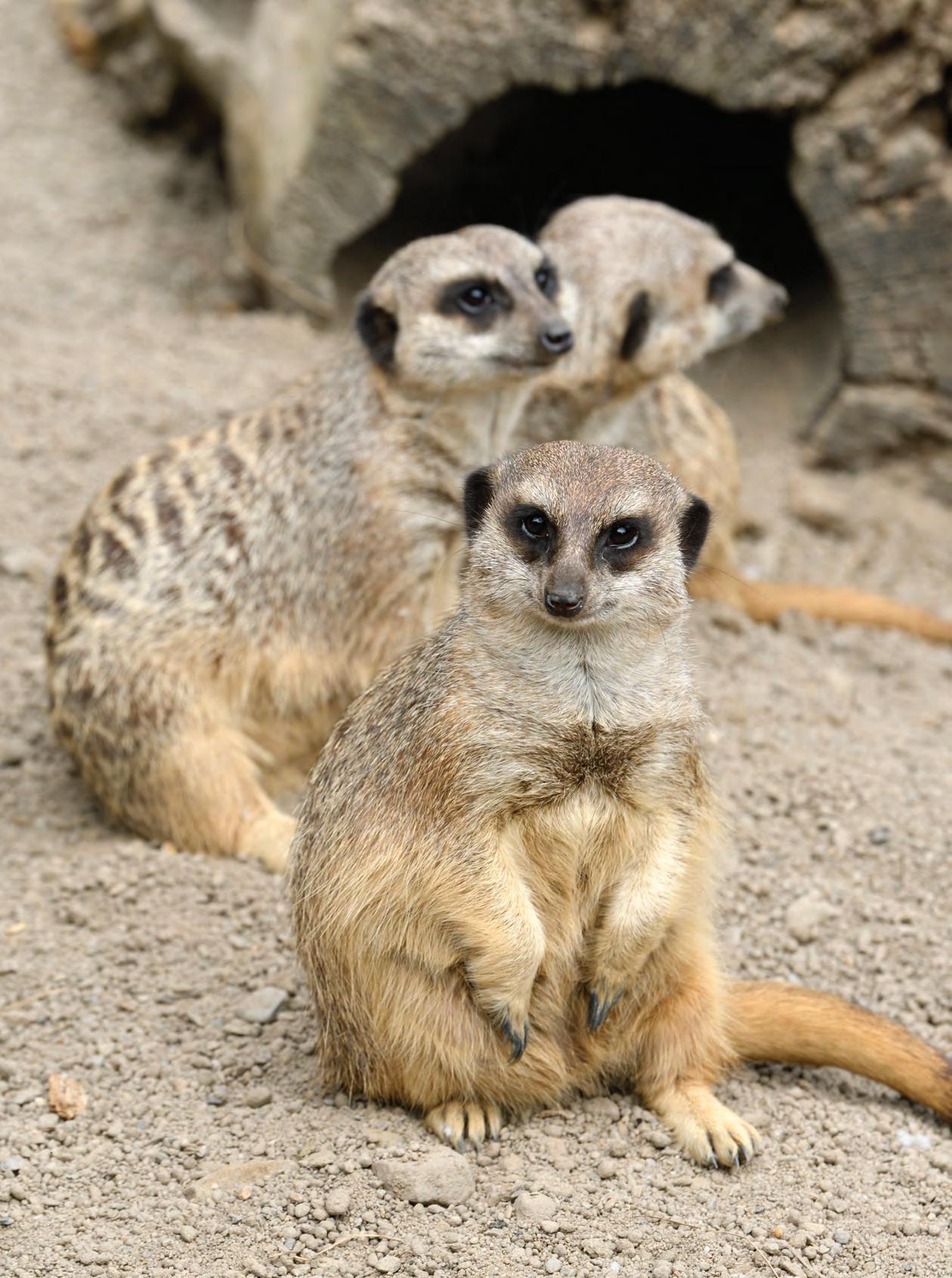
"The hospital's new meerkat enclosure will help take our community outreach work here to a new level while giving young people a chance to get closer to nature and wildlife."
Very special animals
Given that Edinburgh Zoo houses so many remarkable animals, I'm intrigued as to why meerkats were chosen as residents for this project.
"One of the first experiences that our visitors have is spotting the female meerkat mob near the zoo's entrance. Seeing the smiles and excitement that these little animals create is something special. And this initial wow moment can be a first step in piquing visitors' interest in wildlife and our conservation work," says Ben. "We're hoping to transport the magic of this moment to the hospital's new meerkat enclosure."
Over the past two years, Edinburgh Zoo's animal keepers and vets have used their expertise in caring for
meerkats to design an enriching habitat alongside architects, NHS Lothian nurses and doctors, and health and safety and infection control specialists. It's hoped that one of Edinburgh Zoo's community officers will be based permanently at this pioneering space to look after the meerkats and deliver learning and experience sessions through the hospital's nature education programme.
"Although similar projects have been successful in Australia, this partnership is a first for Europe, which is why we're so happy to create such a fantastic
experience for the Royal Hospital for Children and Young People," says Ben.
"The extraordinary mental and physical wellbeing benefits that stem from spending time with animals in nature have been proven time and time again. This new meerkat enclosure will allow children to get outdoors and experience the incredible power of meerkats and nature. Plus, meerkats will love the attention!"
As well as seeking to improve the wellbeing of young people visiting the hospital and strengthening Edinburgh Zoo's community connections, Ben hopes this partnership inspires younger generations to safeguard the future of our natural environment.

"We want to inspire young people to help protect the planet against the challenges created by climate crisis and biodiversity loss. That's why community engagement programmes such as this one are so vital," says Ben. "Awell-cared for planet, where nature can thrive, is the bedrock upon which all healthy societies are built. No matter how big or small the actions our community engagement programmes inspire people to take, it all helps the Royal Zoological Society of Scotland get closer to its vision of a world where nature is valued, protected and loved."
As I get ready to head home, I have one last laugh at Ace's mob standing on their haunches scanning passersby. They may be small in stature, but it's clear just how massive the role is that meerkats play in helping the Royal Zoological Society of Scotland achieve its goals.
That makes the anticipation of seeing the Royal Hospital for Children and Young People's new enclosure come to life all the more exciting. Expect updates in future issues of your magazine as this exciting partnership evolves.
Fancy getting up close to Ace's meerkat mob? Find out more about how you can take part in Edinburgh Zoo's experience days at edinburghzoo.org.uk/ experiences
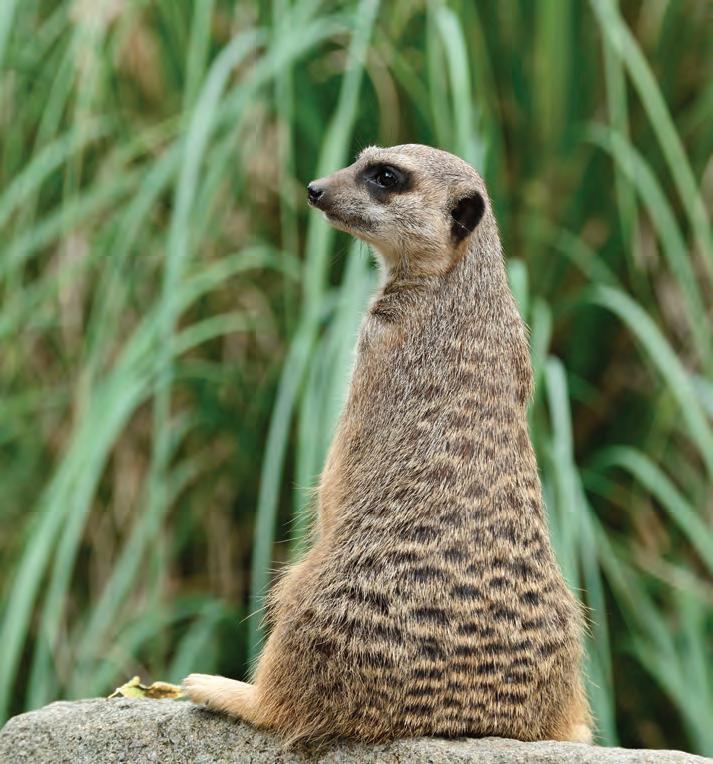
"We want to inspire young people to help protect the planet"
MEERKATS
Ben Supple, Director of Engagement and Business Development
RZSS.ORG.UK I WINTER 2023 39
Did you join Highland Wildlife Park with hopes of becoming a keeper?
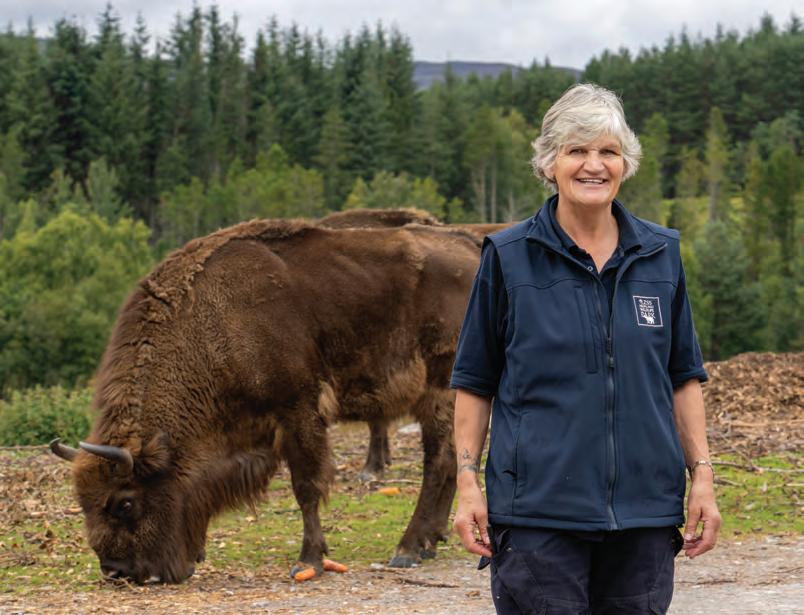


Not at all! I came to work in the shop, a role that I enjoyed. I loved chatting with everyone that came in, and sometimes I helped in the cafe too. I never thought that I might become a keeper.
Why did you become a keeper?
I had never contemplated it, but one day Jeremy Usher-Smith, the park manager at the time, came into the shop and told me that an animal warden's job was coming up -this was the name used at the time for keepers. He told me that I should apply. I was a bit taken aback and wasn't sure it would suit me. It was to work with the brown bears, lynx, foxes, badgers and otters we had during that period. I love challenges and decided to go for it without much more thought.
How did you gain the necessary skills to change role?
It was wonderful, because I was sent off to other establishments such as the
Sea Lifecentre near Oban and a wee stint in Edinburgh Zoo while working to do a City & Guilds course in Animal Management. It was incredibly exciting, and I soon got the hang of it. I do love my work.
Are there many species still at the park from that era?
At that point, Highland WildlifePark was a very different place, and we only had indigenous animals past and present of Scotland. Most of the red deer here today are relations of the first ones we had at the start. When the then owners erected the perimeter fence, the wild herd of red deer were living within the area. They have never left, and we still have their relatives with some new blood brought in from time to time to maintain the health of our herd.
Has the park changed much since you first arrived?
It most certainly has and continues to move on all the time, improving
40 WINTER 2023 I RZSS.ORG.UK
and modifying. RZSStook over in 1986, and now we have a much more comprehensive range of animals -all of them have origins from cold climates of the world. We constantly strive to improve conditions for them, and are always learning new ways to improve what we do to help them and make sure they have a good life, free of stress as far as possible. We have discovered an enormous amount about diets. What suits one breed may not suit anotherour reindeer and elk, for example, need a varied selection of browse daily, while some deer are predominately grazers.
How else has the approach to animal care changed?
We have mastered new methods to work alongside many animals, which means when they require vaccinations, check-ups or have to have treatment, this can often be carried out without tranquillisers. It cuts down stress for both them and us. We now have vets on site, transforming how we care for our animals. Problems are quickly dealt with. We have made new handling facilities, and fenced areas where the animals may wander in of their own accord, and the field shelters we now have here are open on four sides so the animals can move

around and find or avoid the weather that suits them. We have wallows and pools, and other wildlife is moving inbarnacle and greylag geese, lapwings, oystercatchers and numerous other birds come here to breed in spring too. For our wolves, we train them to come to a whistle so that they take plenty of exercise and run in their large enclosure. We recognise the importance of animals being fit and therefore more content.
Which are the most difficult animals that you look after?
Frankly,I have always felt that people are a far more significant challenge to work alongside than animals, but I relish this aspect of my role here. We start each day with a meeting to work out the day's plan -and of course, things don't always go as expected with animals -or people either. No two days are ever the same: people, like animals, have such varied characters, and I love that.
Why do you think Highland Wildlife Park is important?


The future of all our wildlife is crucial and hangs in the balance. People visit zoos and parks and love seeing the animalsand often seeing them close can make all the difference. But it's also important to recognise that RZSShas a global reach and is part of a far bigger picture working alongside other conservation bodies breeding species that are dangerously close to extinction.
Here in Scotland, our successful wildcat breeding project is just one example of the vital work being carried out, often behind the scenes. I love that.
Do you have a favourite of the animals you look after?
I'm so fond of our European bison. They are wonderful animals. They remind me greatly of my family, as they, too are close-knit and stick together. There's also always a matriarch in the herd.
And is that you?
Of course! Who else?
How do you cope when animals come to the end of their lives?
I have always appreciated that there is no welfare in death, but there most certainly is in the stage before. If you are working with animals, it's essential to know when the time has come to let them go to avoid suffering. It's crucial to be realistic about the future of a particular animal. Sometimes making these tough decisions is part of my role. Having the vets on site has made this far easier.
What do you enjoy most about your job?
There is so much that I love. I suppose it's the variety, and it has also allowed me to travel to numerous other zoos and parks not only in this country but abroad. However, that's for the younger team members to do now. I am happy to stay here. I have met some great people and continue to do so, and I love working in a team. And of course, I also enjoy being in charge, which my team members would probably not deny!
LEAVE A GIFT FOR OUR ANIMALS
ZOO MEMORIES
RZSS.ORG.UK I WINTER 2023 41
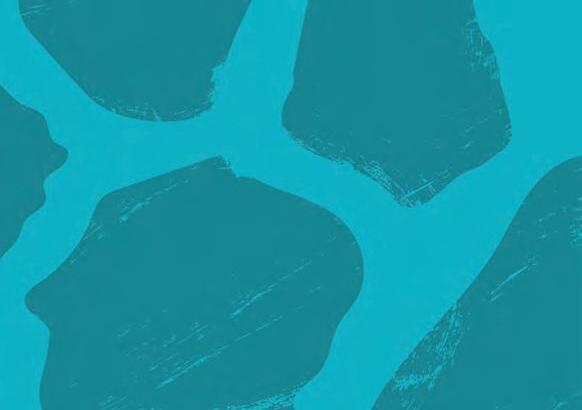


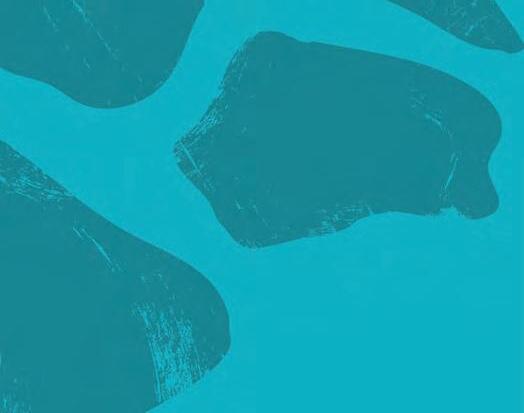


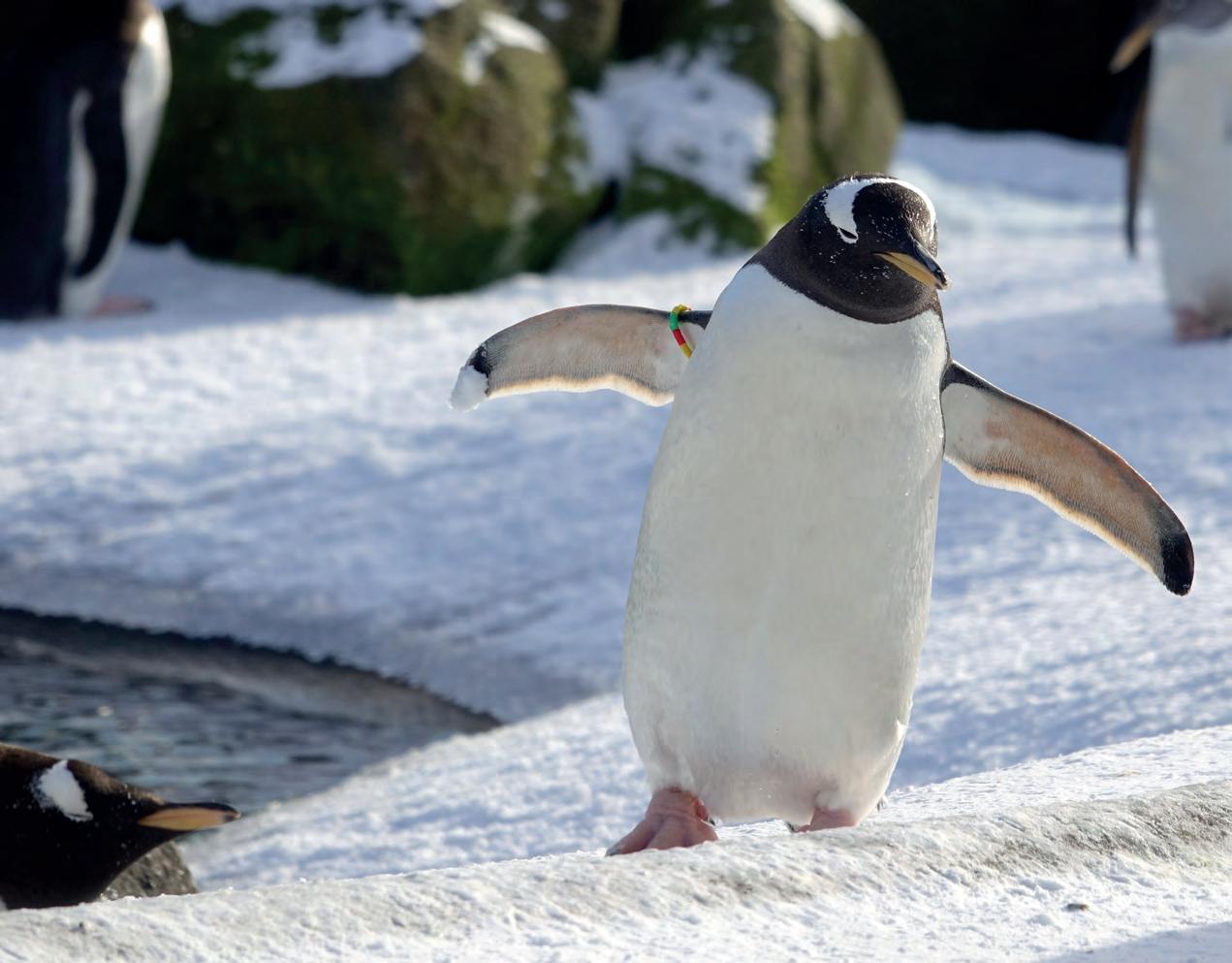








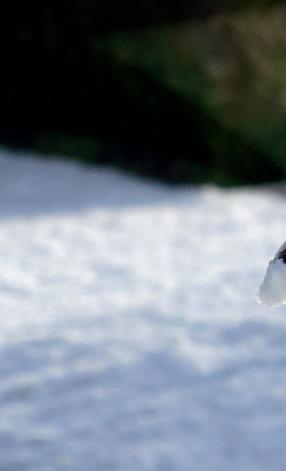
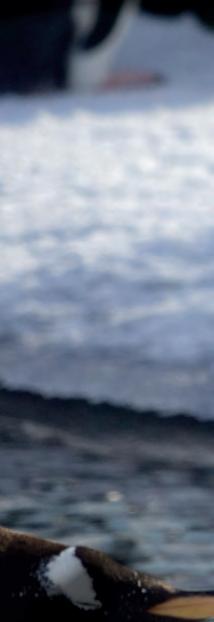

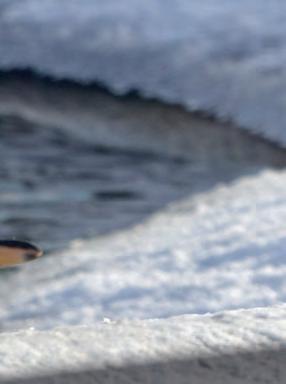

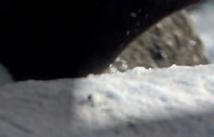


UIDE
Events • Gifts • Membership
Celebrate the holiday season at Edinburgh Zoo's Winter Village, featuring our environmentally friendly Rockhopper Rink. Enjoy browsing market stalls with specially sourced souvenirs from local makers in Lemur Lodge. And join us in welcoming Mr and Mrs Claus back to our grotto from 1 until 24 December, as we host them at our festive breakfasts!
The Winter Village will be operational during zoo opening hours from 1 December to 7 January. The Christmas market is free to enter, however skating tickets and grotto slots must be purchased in addition
to zoo entry tickets (breakfast event tickets are booked online and include zoo admission for non-members).

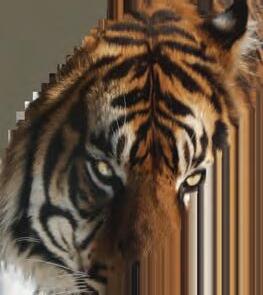
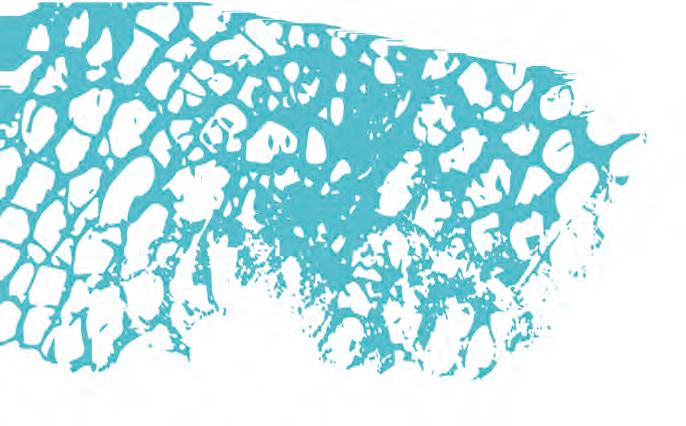
Edinburgh Zoo's Winter Village will also open during the evenings on Fridays and Saturdays from 1-23 December, as well as on Christmas Eve and all the way through from Boxing Day until Saturday 6 January 2024.
In the evenings, the Winter Village will be lit up for skating, shopping, dining and our Mr and Mrs Claus grotto! It's £2 to visit during the evening, or free if you have a pre-booked skating or grotto slot. Please book in advance to avoid disappointment.
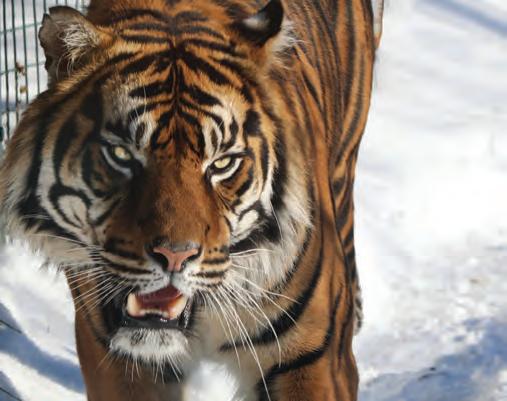
RZSS.ORG.UK I WINTER 2023 43
PENGUINLOVEPEBBLES
Edinburgh Zoo
I 11jt:1ijij 10am-2pm
Stop by Lemur Lodge and paint a pebble for our penguin nests this breeding season. Will your pebble be chosen by one of our lovely penguins? Be in for a chance of naming a chick if it is! No advance booking is required to participate.

£3 per pebble, subject to availability.
1-IIGHLANDWILDLIFE PAR\(WILD WOR\(SHOPS
Kincraig Community Hall
6lil!l 10:30am-1pm
t..Jl•fli4pm-6:30pm f.Dm mm!J4pm-6:30pm mm!J10:30am-1pm 4pm-6:30pm
Free of charge family drop-in sessions at the Science Skills Academy's Newton Room in Kincraig Community Hall.
SAV[INGJ:SCOT!ISH WI DCAS IAlr--
Edinburgh Zoo
t-fi•t!i6:30pm-7:30pm
Free talk about wildcats in the Budongo Lecture Theatre (see page 26). Booking essential -email events@rzss.org.uk
zoo soot BREA\(fASTS
Edinburgh Zoo
h-Fht•t.Pl•t!i9am-11am
Get into the Halloween spirit this October with our exclusive pre-opening breakfast tour! You'll hear lots of weird and wonderful facts as you make your way through the zoo before enjoying a devilishly delicious breakfast in the Gannet! Themed crafts and activities will also take place for all the family to enjoy.
Adult: £28; Adult member/patron: £14
Child: £32; Child member/patron: £22 Under 3: £22 (activities and pancakes included) or £5 (fruit and yogurt breakfast) Carer (ID required): £12
To book: edinburghzoo.org.uk/ zoo-boo-breakfasts
CARVEA TREAT
Edinburgh Zoo
28 and 29 Oct 10am-3pm
Over the Halloween weekend, stop by Lemur Lodge to carve for our animals a spooktacular pumpkin treat! £3.50 per pumpkin, while pumpkins last!
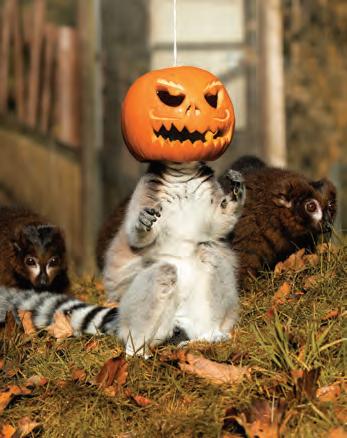
To book: edinburghzoo.org.uk/ carve-a-treat
NEWYEAR'SDAYTOUR
Highland Wildlife Park
l:lm 11:30am-2:30pm
BEAUTYANDTHE BEASTIES:VALENTINES EVENINGATTHEzoo

Edinburgh Zoo
Be our guest this Valentine's Day for a truly ZOOnique date night including a candlelit three-course meal in our Mansion House, along with a splendid bottle of wine.
Entry for this event is through our members gate at the top of the Edinburgh Zoo car park.
£150 for two adults
£137 for two RZSSmembers/patrons
To book: edinburghzoo.org.uk/ beauty-and-beasties
I-IALLOWEENI-IOOTS
Edinburgh Zoo
t.f4Jl•t!i5pm-7pm
Dare to enter the zoo after our gates are closed? Enjoy a Halloween-inspired animal antics show followed by an eerie tour. Tickets must be booked in advance.
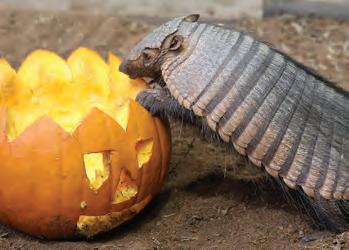
Adult: £17; Adult member/patron: £15
Child: £12; Child member/patron: £10
To book: edinburghzoo.org.uk/ halloween-hoots
Join our discovery rangers for a free, one-hour tour around Highland Wildlife Park to find out more about our amazing animals.
Wheelchairs and mobility scooters are available for hire on a first-come, first-served basis from the visitor centresubject to weather conditions.
Advance booking is essential and tours are limited to 25 people per timeslot. Please let the team know if you would like more information by emailing events@rzss.org.uk
44 WINTER 2023 I RZSS.ORG.UK
DIJ!ti10am-3pm
ROC\(HOPPERRIN\( AT THEWINTERVILLAGE
Edinburgh Zoo
lla.J49:flfflff
Grab your loved ones and hop over to the zoo for iceless skating on Rockhopper Rink this winter!
Friendly to the environment and perfect for novice skaters and experts alike, our synthetic rink is suitable for those aged three and up. Children must be supervised and those under eight years old accompanied on the rink. Skating boots are provided and slots are 30 minutes long.
Skating can be purchased on a walkup basis, but to avoid disappointment we advise booking online in advance.
Daytime Skating
Skating slots are at 10:30am, 11:15am, 12pm, 12:45pm, 1:30pm, 2:15pm and 3pm.
Adult: £9; Child: £9; Member/patron: £6.50
Evening Skating
Skating slots are at 4:45pm, 5:30pm, 6:15pm, 7pm, 7:45pm.
Adult: £11; Child: £11; Member/patron: £8.50 To book: edinburghzoo.org.uk/ winter-village
MR ANDMRSCLAUSAT THEWINTERVILLAGE
Edinburgh Zoo
Daytime Grotto
Make your little one's day at Edinburgh Zoo extra special this festive season. Meet Santa Claus and Mrs Claus at our Christmas Grotto and receive an exclusive early festive surprise!
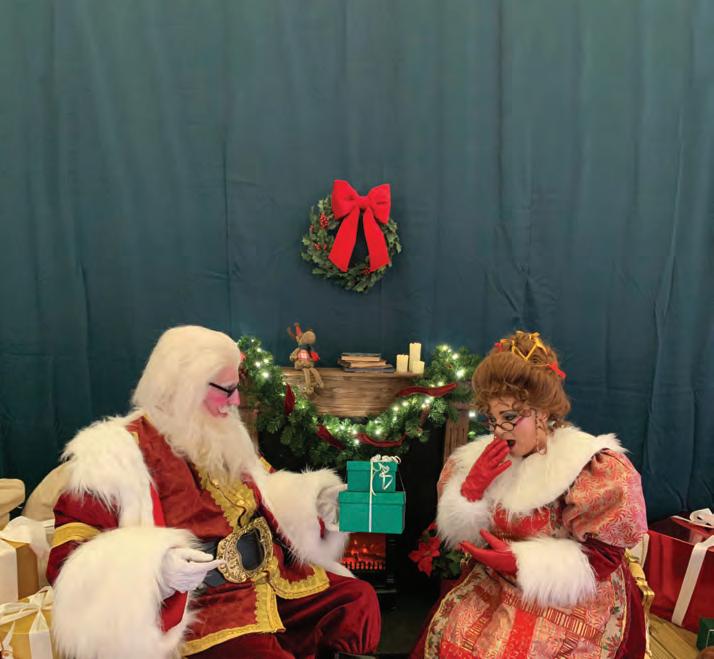
Please note the grotto does not include entry into Edinburgh Zoo.
Admission tickets must be purchased alongside your Christmas Grotto tickets. Daytime slot prices: £18 for one child, £33 for two, £49 for three, £69 for four Evening Grotto
1,2,8,9,15,16,22,23,24Dec
4:30pm-8:30pm
At this time, our animals are tucked up in bed, so zoo admission tickets are not required for evening grotto slots. Access to the grotto at night will be through our festively themed members gate. Evening slot prices: £19 for one child, £34 for two, £50 for three, £70 for four To book: edinburghzoo.org.uk/grotto
CHRISTMASMARl(ETAT THEWINTERVILLAGE
Edinburgh Zoo
H1oJ49:fifflff10am-3:30pm
Support local this Christmas and pick up some fabulous gifts at our Winter Village Christmas Market! Interested in having a stall? We may still have some space and would love to hear from you!
Please email events@rzss.org.uk for more information.
Edinburgh Zoo
3, 6, 10, 13 Dec
12:30pm-3pm
Add a touch of homemade charm to your Christmas by taking a wreath making workshop with our expert gardens team. We'll show you how to create a beautiful 14-inch sustainable wreath decoration, with materials naturally sourced from Edinburgh Zoo. Each session is three hours long, and suitable for participants aged 13+. Participants aged 15 and under must attend with an adult over 16.
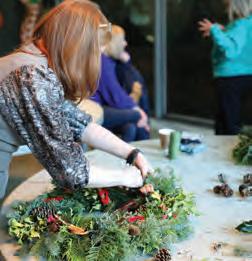
Tickets include entry into Edinburgh Zoo and sessions will take place in our Budongo Trail building. Hot drinks and festive sweet treats will also be provided.
To book: edinburghzoo.org.uk/ wreath-making-workshop
"' ""'
• I'-
15th Anniversary Programme: Wildlife Festival
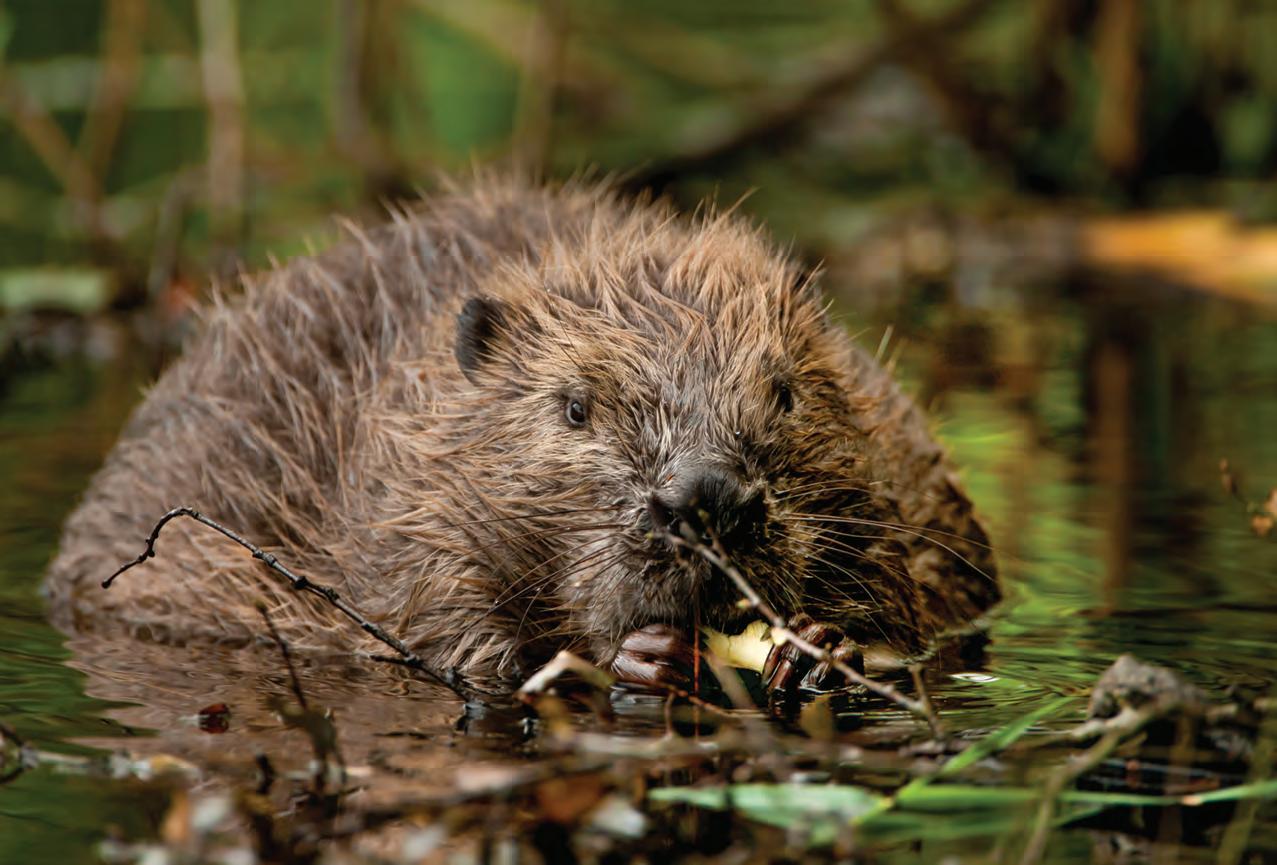
28 July - 3 Aug 2024

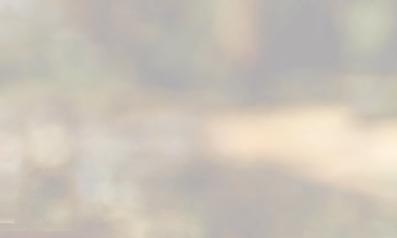
• Visitor Centre
• Guided & bespoke walks
Photo & viewing hides Seashore safaris
• Education work
• Consultancy
1. BUY A GIFT MEMBERSHIP
Love your RZSSmembership? Treat a friend or family member to gift membership and they too will enjoy unlimited visits to Edinburgh Zoo and Highland Wildlife Park, along with free entry to 12 other zoos across the UK and Europe, all year round. From just £71.50 for adults and £38 for children, our membership is the perfect gift for any occasion. Read more about gift membership at rzss.org.uk/membership
2. ADOPT AN ANIMAL
Looking for a gift that keeps on giving? Adopt an animal from one of the many amazing species cared for at Edinburgh Zoo or Highland Wildlife Park. Not only does your support allow us to look after the animals at our parks here in Scotland, but it also helps our conservation work across the globe. Each adoption arrives as a customisable gift pack and you can choose between Cub, Bronze, Silver, Gold and Platinum levels.
Place an order by Tuesday 5 December for the animal lover in your life, to arrive in time for Christmas. Get started now at rzss.org.uk/adopt

3. BOOK A KEEPER EXPERIENCE
Want to experience the ultimate encounter with our animals? RZSSkeeper experiences offer a once in a lifetime
WIT~USI
For further information, please contact our events team on 0131314 0336 or email events.edinburghzoo@ compass-group.co.uk
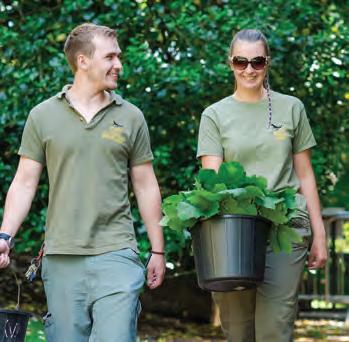

opportunity. There are a range of different packages to choose from, including both full and half-day experiences, in addition to junior and mini experiences for youngsters. Alternatively, you can enjoy a Magic Moment and get up close and personal with a range of our animals, including penguins, rhinos, meerkats, armadillos, sloths and giraffes. edinburghzoo.org.uk/experiences
4. SPONSOR A WILDCAT
Turn to page 26 to read about our important work with the Saving Wildcats project. Your donation of just £5 a month will help us to save the Highland tiger. You can choose to sponsor one of three wildcats in the conservation breeding for release centre at Highland Wildlife Park, each with their own unique personalities: Fruin, Drama or Cranachan. Who will you pick? Register for sponsorship today and be part of our ambition to help bring wildcats back from the brink in Scotland. savingwildcats.org.uk/sponsor

* I-PSTY 0 UR C~RISTMASPARTY
GIFTING
RZSS.ORG.UK I WINTER 2023 47
I-IRISTMASeRESENTs,
Visit our shops at Edinburgh Zoo and Highland Wildlife Park or head online to shop.rzss.org.uk to explore our brilliant range of festive gifts for: the animal lovers in your life
PERSONALISED BAUBLE
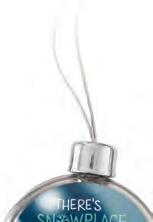
0 Create your RZSS Personalised Christmas Bauble for a loved one this festive season. Choose from five fun designs and add up to 15 characters of text. Each bauble is 8cm in diameter
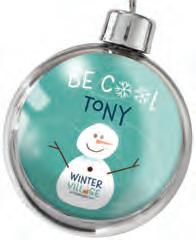
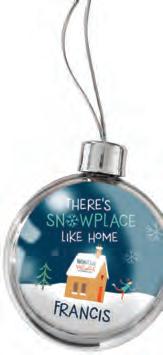
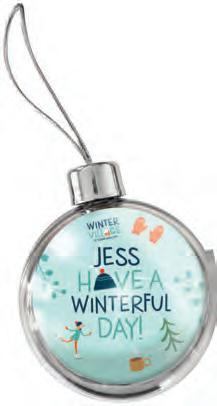
and the image can be viewed from both sides.
£6.50 E
WARMIES
0 Warmies® are fully heatable soft toys that can be warmed in a microwave to provide hours of cosy comfort. These luxuriously soft plush designs are gently scented with relaxing lavender and can be reheated time and time again!
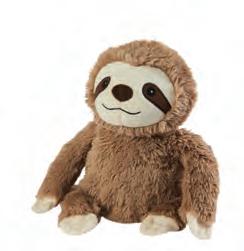
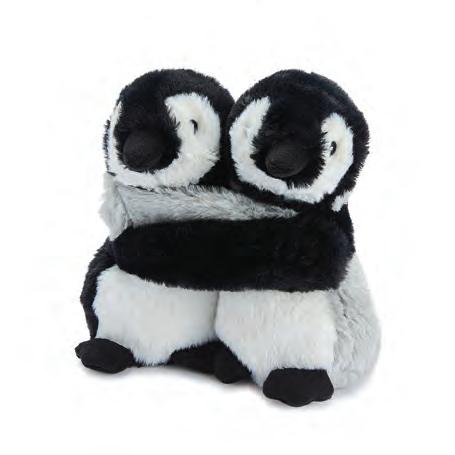
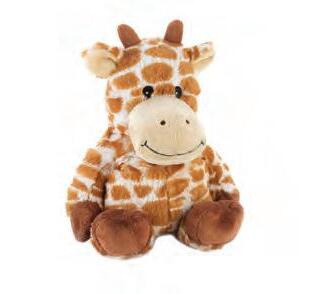
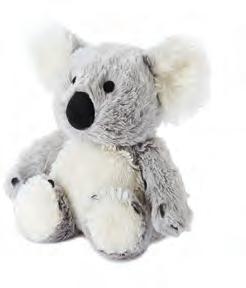
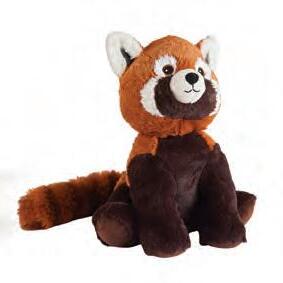
From £22.50 E G

A4 WALL CALENDAR
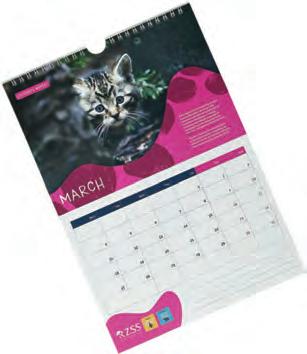
0 The RZSS2024 Wall Calendar is packed with fantastic photos of our captivating critters, as well as lots of educational info. As you tally up your days, you'll be picking up wildlife knowledge and learning fun facts throughout 2024, so get set for a year of conservation coolness!
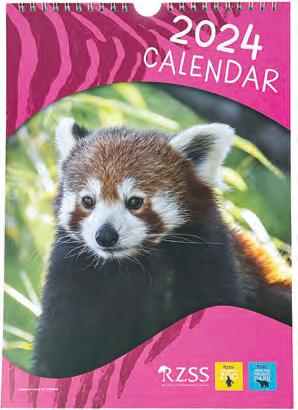
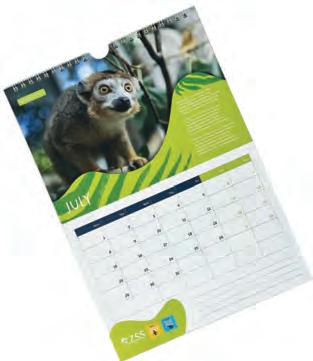
£6.50 E G
CHRISTMAS JUMPER
0 Our Edinburgh Zoo Christmas Jumpers come in two different funky and festive penguin designs. They're available in sizes XS-2XL in a standard fit and have been produced in limited editions, so don't miss out!


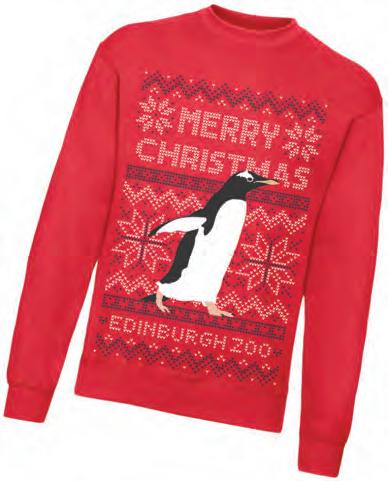
£27.50 E G
AVAILABILITY
E Edinburgh Zoo shop
Highland Wildlife Park shop
G Online shop


GIRAFFE BAUBLE

0 This festive Glass Bauble features a bespoke Edinburgh Zoo Christmas design by artist Emma Ball, showing our famous giraffes in their very own winter wonderland. It's the perfect addition to any Christmas tree. Dimensions: width 7.5cm, height 9cm and drop length 16cm.
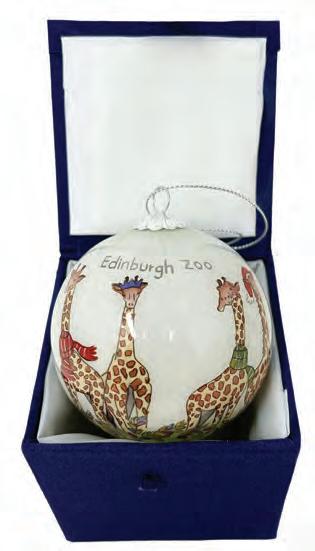
£15 E ffll
During a big year for the Saving Wildcats project, we're celebrating with a gorgeous range of wildcat-inspired gifts
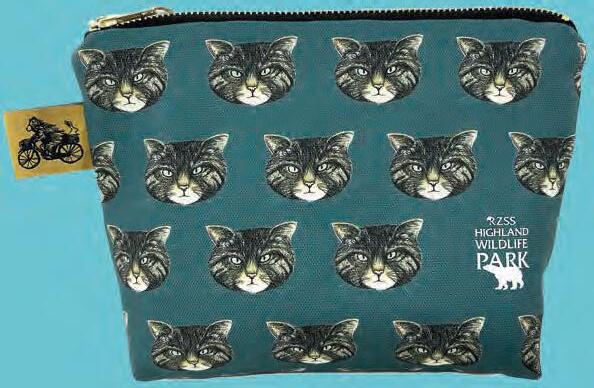
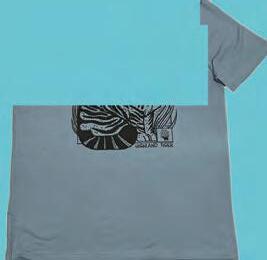


Q This Scottish Wildcat Soft Toy is just so cute and cuddly! Made exclusively for RZSS, our furry feline stands approximately 18cm tall. The soft toy comes with a bespoke label featuring information about the Saving Wildcats conservation project.

£20 E ffll
Q Show your stripes in our Highland Tiger T-shirt that comes in stone blue or green. Soft and sustainable organic cotton fabric ensures you stay comfortable all day long, while our unique wildcat design helps you stand out from the pack.


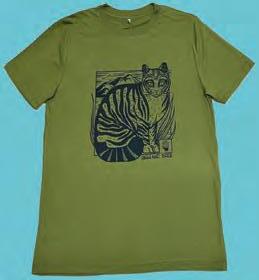
£20 G
0 A stunning heavy base Whisky Tumbler with a Scottish wildcat etching. This is a beautifully balanced glass, standing 8cm high with a 6.5cm diameter. Presented in a recyclable gift box.
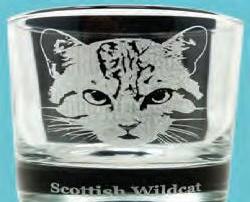
£10 E ffll
CHERRYWOOD EARRINGS
0 Our eco-friendly Animal Earrings are all made in the UK. They're hand-painted, made from cherrywood and come with stainless steel posts.

£12.95 E ffl)





0 Willow the Wildcat is a children's book about a fierce wee wildcat and her family as they search for a new home in a Scottish forest. Written by Lynne Rickards, with beautiful colour illustrations of Scottish landscapes and native Scottish animals by Kirsteen Harris-Jones.
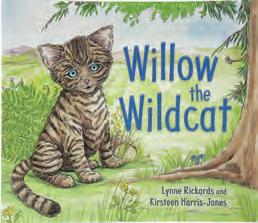
£6.99 E ffl)
Q This Wildcat Wash Bag is designed in Scotland by Catherine Redgate exclusively for Highland Wildlife Park. Made with 100% cotton and lined with wipeable material, the wash bag has a gold pull zip closure and gold bear on a bike Catherine Redgate tag. It measures approximately 15cm high, is 21cm wide when flat, and has a gusseted 5cm depth to the base giving a triangular finish and a flat bottom.
£15 G
Q Our RZSSWildcat Candle comes wrapped in wildcat print fabric. These soy candles are all hand-poured in small batches here in Scotland, with a fragrance combining citrus notes and spices to reflect the wild places in which the cats make their home.
£20 G

RZSS.ORG.UK I WINTER 2023 49
Above: Anna feeds the herd of giraffes
Below left: Anna with the RZSS WildGenes team
Below right: Johnny Appleyard and Kara Dicks from RZSS also spent a day at Glenmorangie
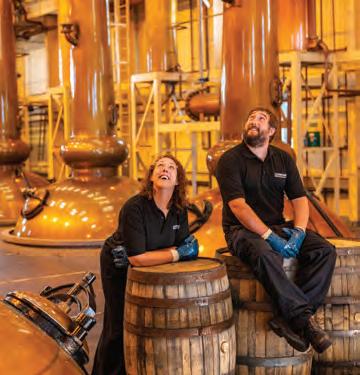
For the past four years, Anna Patterson has expertly crafted Glenmorangie's Highland single malt. But she recently took a day out from her role as production operator to spend some time with Edinburgh Zoo's herd of beautiful giraffes.
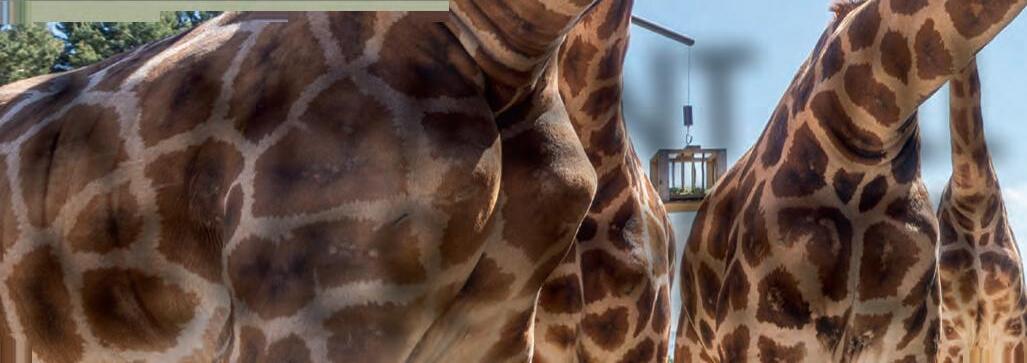
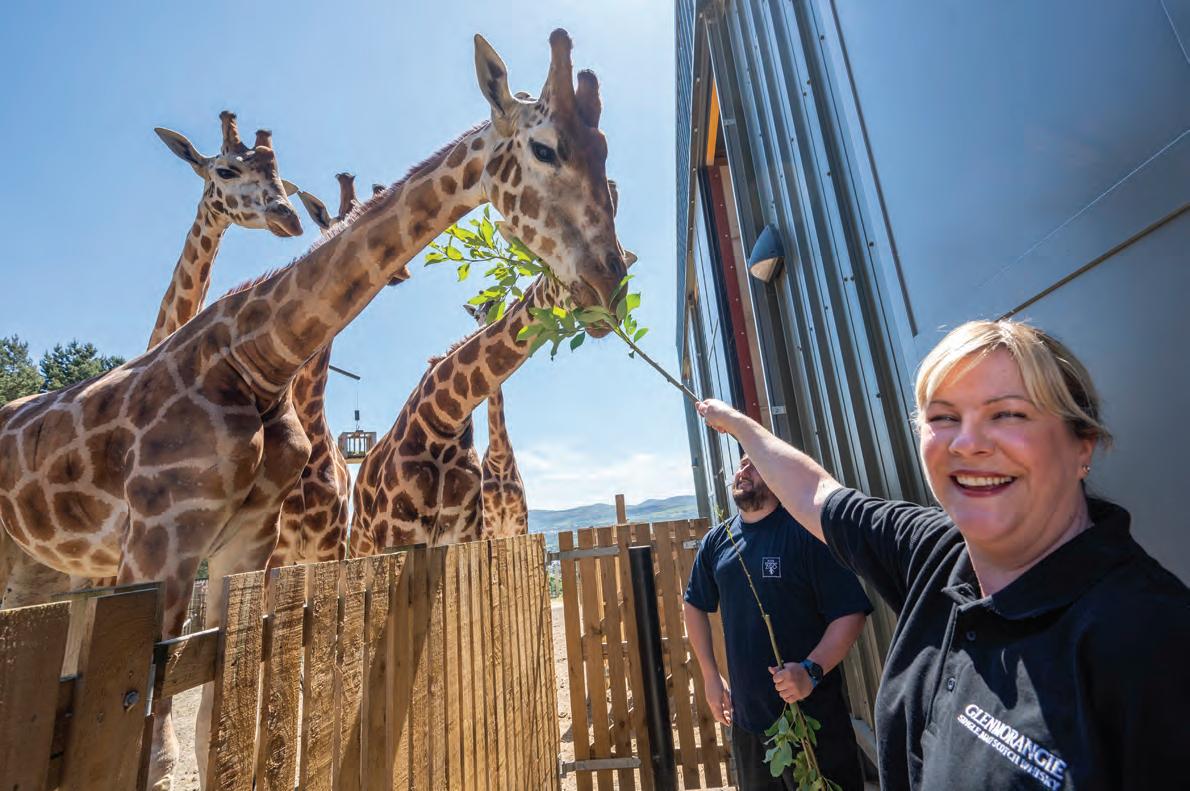
"Wildlife and nature have always been a true passion of mine," says Anna. "So, when this opportunity to visit Edinburgh Zoo's giraffes came up, I think that's why I came to mind!"
The giraffe has long been a beloved symbol for Glenmorangie as their whisky stills stand tall at the same height. The firm works in partnership with RZSSand the Giraffe Conservation Foundation (GCF)to safeguard the wild giraffe population in Africa, where poaching and habitat loss have contributed to a 30% decline in numbers in as many years.
Glenmorangie also funded Edinburgh Zoo's giraffe enclosure, where Anna got up close to our five Nubian giraffes: Ronnie, Arrow, Gerald, Fennessy and Gilbert.
"The giraffe enclosure is amazing," she says."lt was brilliant to witness the keepers' dedication and the pride they take in looking after the giraffes. Their passion is infectious."
Anna also quickly learned just how much our giraffes love to munch on their favourite snack, willow leaves. "Being so close to the giraffes was incredible," she recalls. "You could feel their strong yet gentle energy. Feeding the giraffes was a real pinch-me moment as I watched them strip the willow leaves from the branches with their enormous tongues."'
On her day at Edinburgh Zoo, Anna also visited our RZSSWildGenes laboratory, the UK's only zoo-based genetics lab. Here she was shown the DNA research we're conducting through our partnership with Glenmorangie to help GCF reintroduce Nubian giraffes to areas of Uganda where they're locally extinct.

"Learning about gene mapping and sequencing was fascinating," says Anna. "The lab's work is so important to improving our understanding of giraffes and helps support these animals both here at Edinburgh Zoo and in their natural habitat."
Anna has since deepened her understanding of the threat giraffes currently face.
She says: "It makes me extremely proud to work for Glenmorangie, knowing that they invest so much in vital projects such as the partnership between RZSSand GCF. Being able to play my part in helping such worthwhile causes is really

118eing able to play my part in helping such worthwhile causesis really rewarding11
50 WINTER 2023 I RZSS.ORG.UK
Whiskymaker Anna Patterson



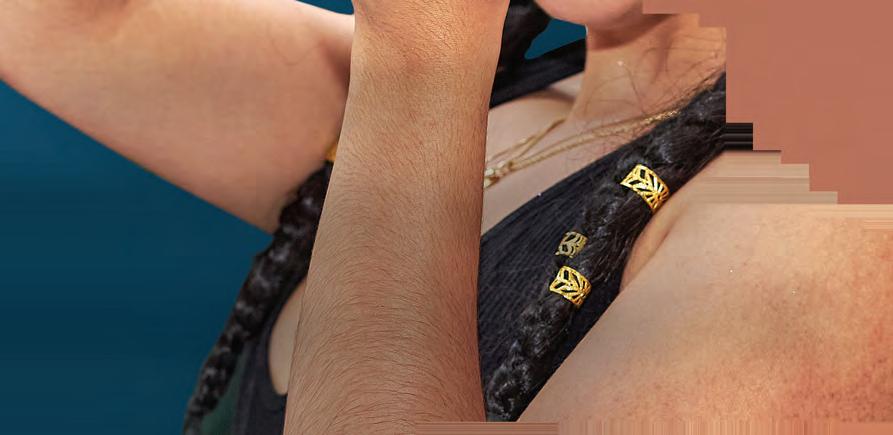




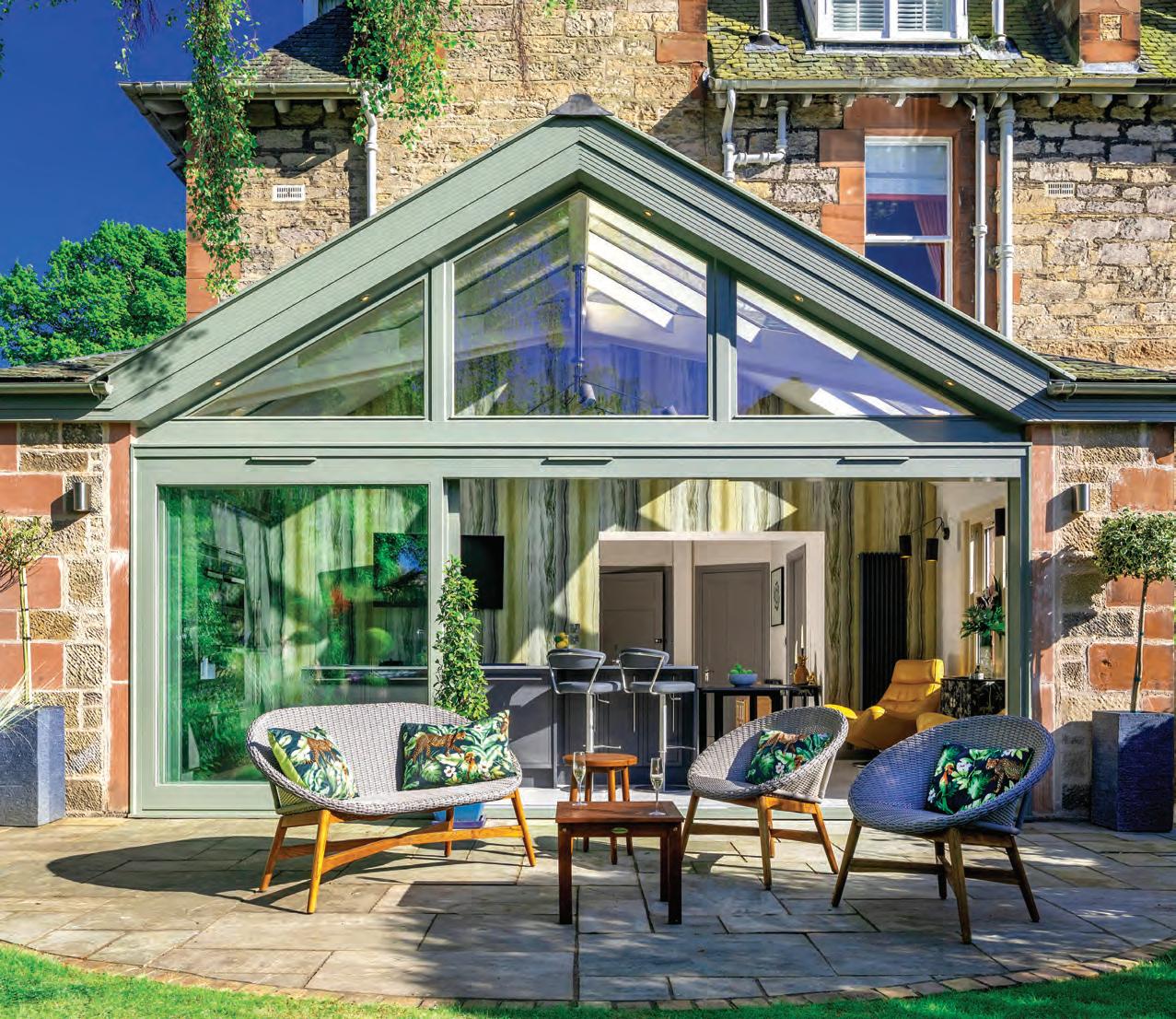
Conservatories j Orangeries To find out more call us on 0345 050 5440 II 1!1..-.: •. Visit our design centre or request a brochure. Sun Lounges j Garden Rooms Mozolowski & Murray Design Centre 57 Comiston Road Edinburgh EH 10 6AG Open 6 days Monday to Saturday 10am to 4pm. www.mozmurray.co.uk





























































 Nico the sloth Nico, who moved into Edinburgh Zoo's Sloths and Armadillos building this summer, was recently photographed by nature photographer Laurie Campbell
Nico the sloth Nico, who moved into Edinburgh Zoo's Sloths and Armadillos building this summer, was recently photographed by nature photographer Laurie Campbell






 Partners in the Rare Invertebrates in the Cairngorms Project, including members of the RZSS conservation team, prepare to release dark bordered beauty moths into the wild
Partners in the Rare Invertebrates in the Cairngorms Project, including members of the RZSS conservation team, prepare to release dark bordered beauty moths into the wild















































































 Senior Carnivore Keeper Judith Bowman on our Arctic fox cubs
Senior Carnivore Keeper Judith Bowman on our Arctic fox cubs
















































































































































